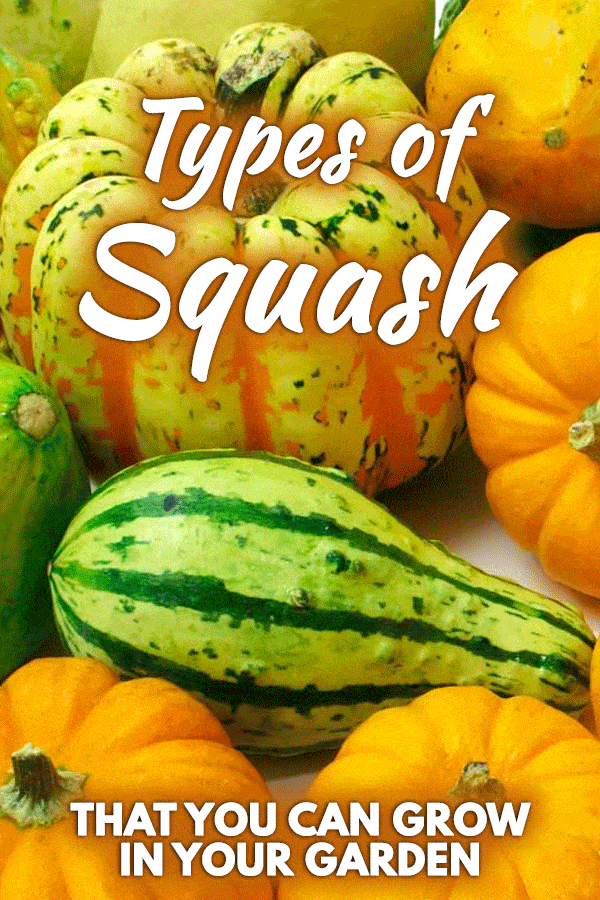
Squash is the common name for four species in the Cucurbita genus that comes under the Cucurbitaceae family. Squashes originated in America. They are characterized by unisexual flowers, hairy stems, and a fleshy fruit having a leathery rind. Squash is a type of false berry that is called a pepo. Squashes greatly vary in shapes, sizes, and colors.
Summer Squashes and Winter Squashes
Squashes are primarily classified into two types which are summer squashes and winter squashes. One may think they have been named based on the season they are available but in reality, both types are available all year round. Summer squashes are called that because their fruit is ready to be harvested in warm months of summer, while the fruit of winter squashes is not ready to be harvested until the end of summer.
Squashes are extremely nutritious with significant quantities of Vitamin C, Vitamin A, riboflavin, niacin, and iron. However, with their strikingly attractive appearances, aroma, and taste, they offer a unique culinary and visual experience.
Types of Squashes That You Can Grow
Squashes are grown in the vegetable garden very commonly. They are very easy to grow. Before you grow squash, you should have a sound knowledge about the types of squashes. This would make you understand the type of squash you have and you will able to prepare your garden accordingly.
Once you have your heart set out on a particular kind of squash, make sure to check out this post about the top 50 online stores for buying pumpkin and squash seeds.
1. Zucchini
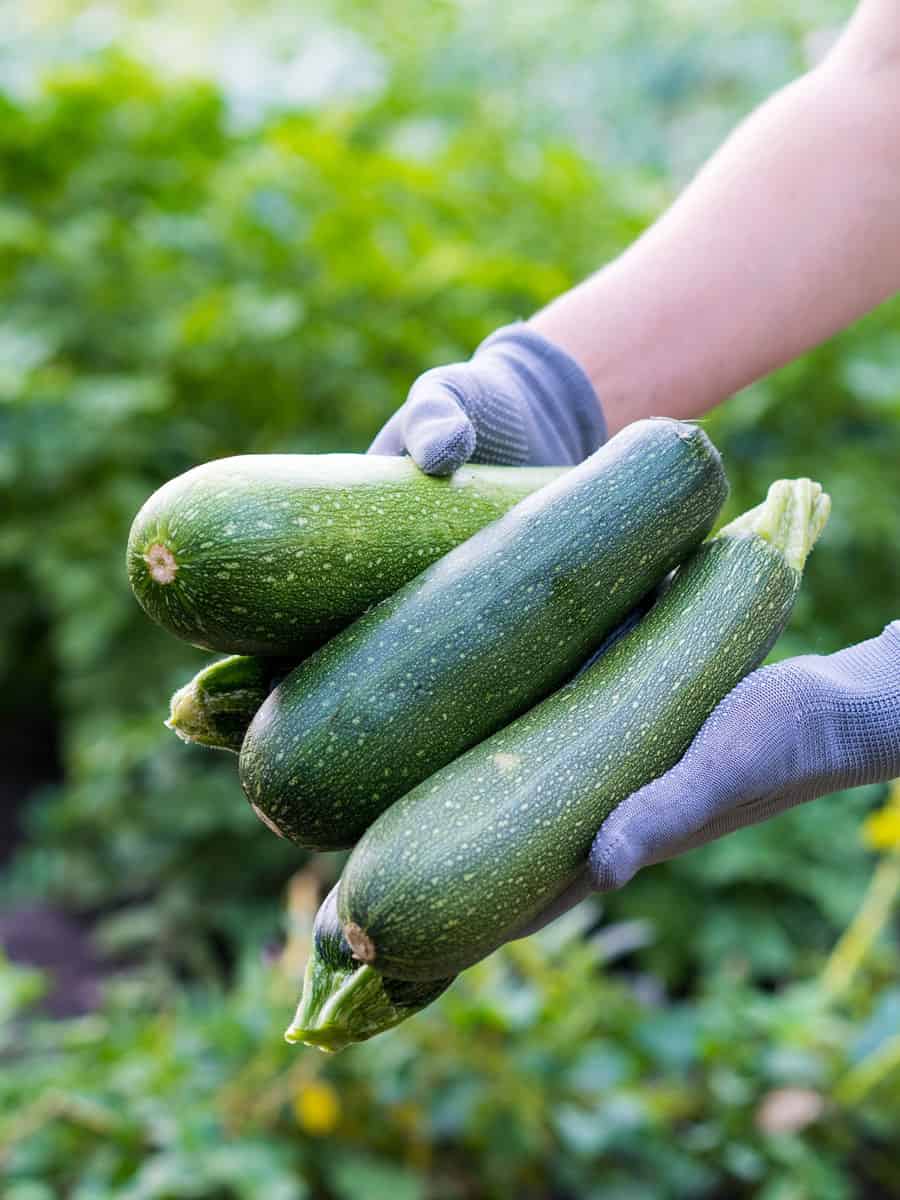
Zucchini is a summer squash that grows to a height of about 1m. Zucchini is a cultivar of marrow that is found in Ireland and Britain. It is known as baby marrow in South Africa. Zucchini is a light or dark green squash in color. Golden zucchini is a hybrid that is orange or deep yellow in color. Zucchini is cooked as a vegetable. It can be used in numerous delicious recipes.
They are native to Mexico and Central America and are grown throughout the United States during the warm season. The growth zones of Zucchini are 2 to 12. It requires a soil that is rich in compost and is well-drained. They need at least 1 inch of water per week. The pH requirement for the optimum growth of this plant is 6.0 to 7.5. It prefers growing in areas that receive full sun. Zucchini plants need at least 1 inch of water per week.
Since Zucchini loves warm weather, the seeds should be planted when the temperature of the soil is 65 to 70 degrees. In zones where temperatures are warmer, two crops of Zucchini are planted, one in spring and the other in fall. However, in temperate regions (zone 6 or lower), Zucchini is planted in summer (usually in May).
2. Butternut Squash

The scientific name of Butternut Squash is Cucurbita moschata. It is known as butternut pumpkin or gramma in New Zealand and Australia. It is a winter squash that grows on vines, growing as long as 15 feet in length. Butternut squash has a light yellow colored skin with orange flesh. When it is ripe, it becomes a deeper orange in color. Technically, butternut squash is a fruit but it is cooked in numerous recipes like a vegetable such as soups, pies, muffins, etc.
Butternut squashes are grown widely in Japan, Tropical America, and in some districts of the United States. They are quite easy to grow. Since they are summer plants, they should be planted when the soil temperature is 60 to 65 degrees at a depth of 4 inches. They require fertile and well-drained soil, having a pH of 6.0 to 6.8. Butternut squash grows best in areas that receive full sun.
The seedlings would freeze in the slightest of frost hence warm temperature is extremely crucial.
3. Spaghetti Squash
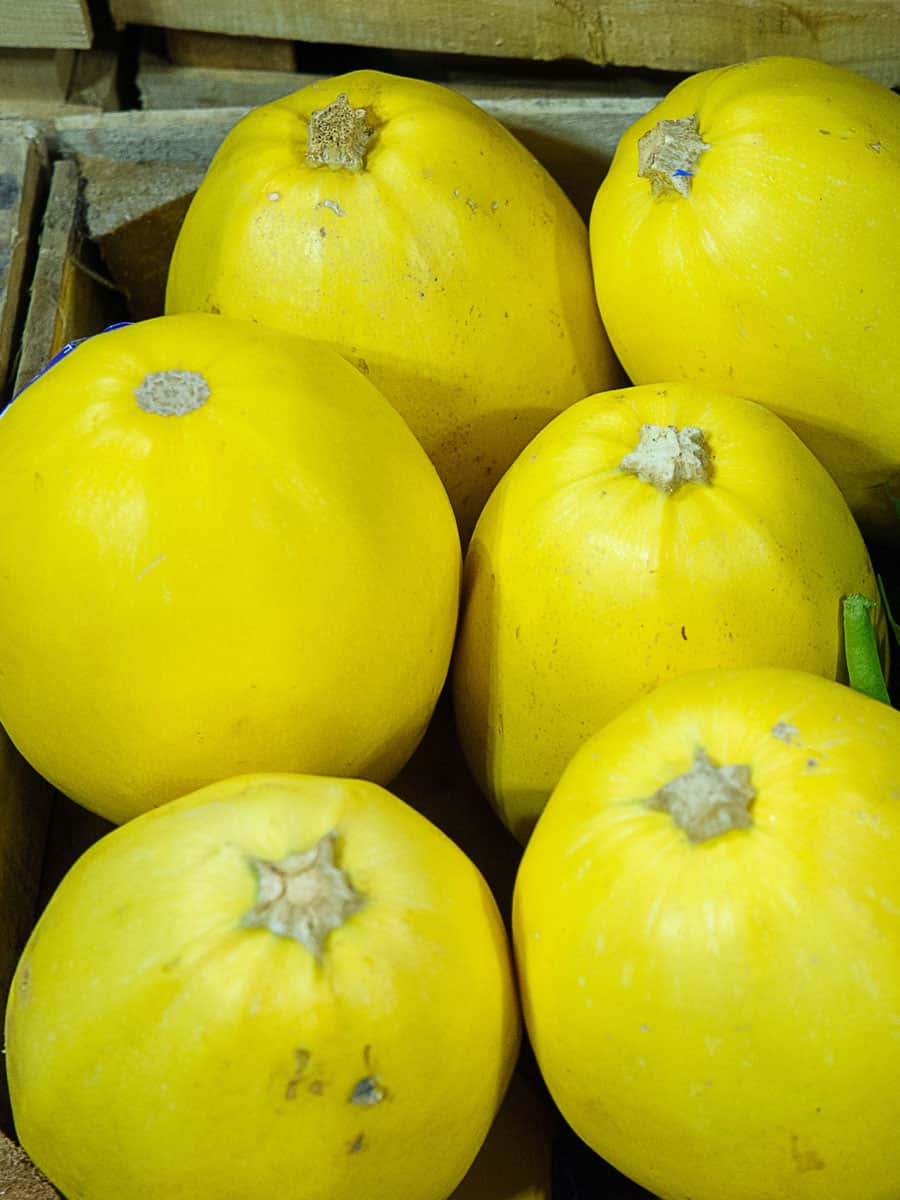
Spaghetti squash is a winter squash that is native to Central America and Mexico. It has short vines that have an upright and a sturdy growth habit. The plant grows to be about 2 feet tall and 3 feet wide. Spaghetti squashes can range from tan yellow to orange in color. They have been named so because the flesh of these squashes is like spaghetti.
Spaghetti squashes need a fertile and well-drained soil for best growth. The soil pH preference is 6.0 to 6.8. They require full sun exposure for optimum growth. They should be planted after the last frost has passed. The right time to start sowing Spaghetti squashes is May. These squashes can be cooked variety of ways and are used in numerous recipes.
4. Acorn Squash
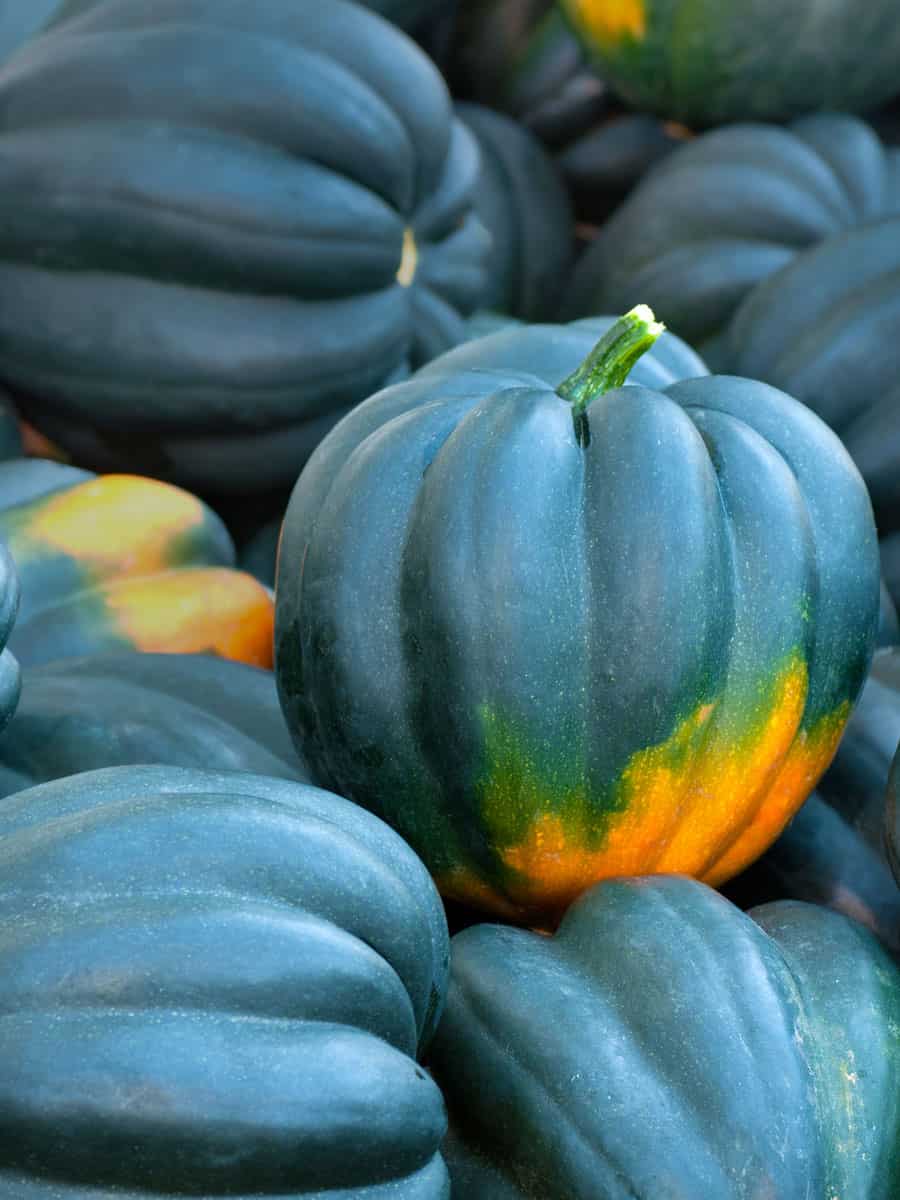
Acorn squash is also known as pepper squash or Des Moines squash. It is a type of winter squash having distinctive longitudinal ridges on its outer green surface and a rich yellow-orange colored flesh. Acorn squashes are about four to seven inches long.
Acorn squash originated in Central and North America. The seeds of Acorn squash need warmth for germination. They should be planted when the temperature of the soil has risen to at least 60 degrees. They need highly rich soil for growth. You will need to fertilize the soil regularly to achieve the best growth of these squashes. Along with full sun exposure, these squashes need a soil pH of 5.5 to 6.8 for optimal growth.
Acorn squash is mostly eaten baked but can also be sautéed, steamed, or microwaved. It is used in a number of savory recipes.
5. Delicata Squash
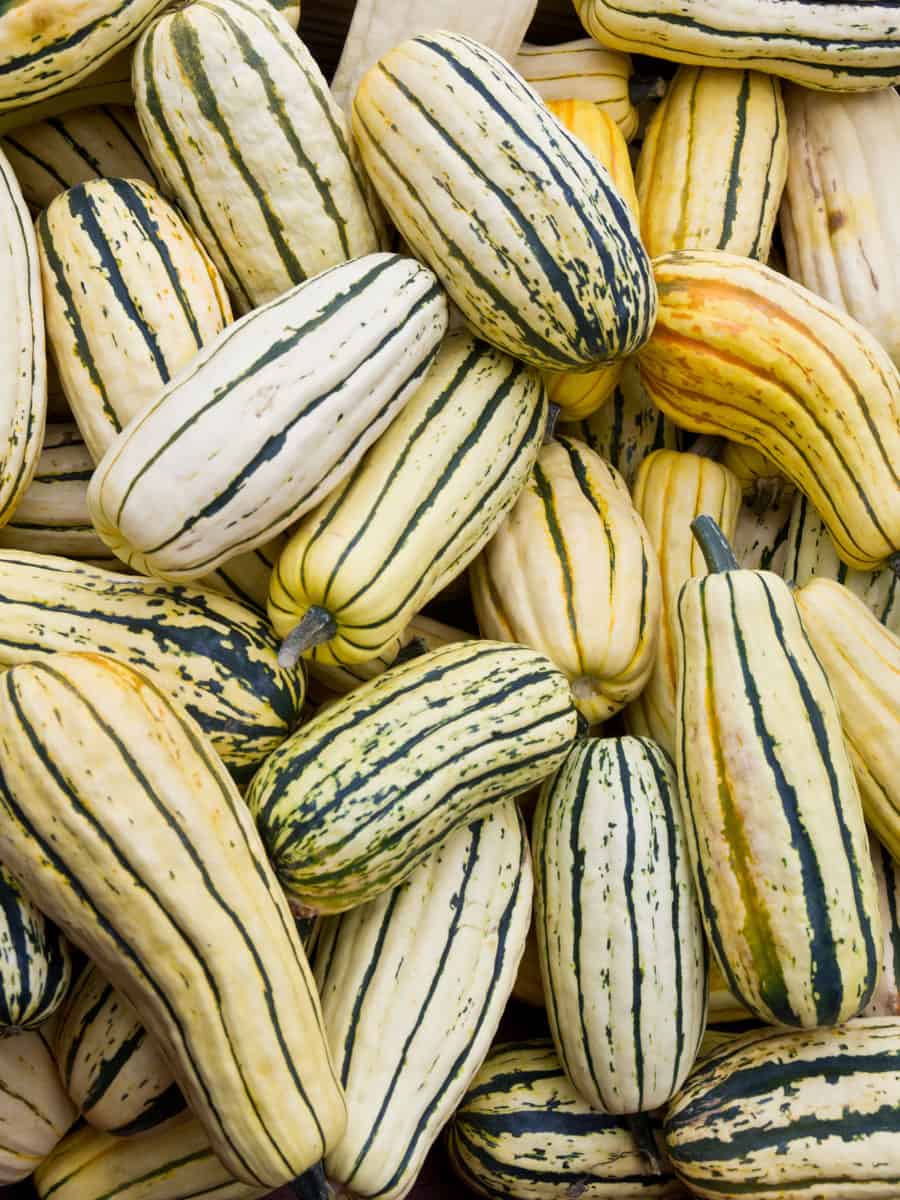
Delicata squash, as the name indicates, is a delicate squash variety that is native to Central and North America. It is a vine plant; therefore, it requires a lot of space to grow. Delicata squash has cream-colored skin with green or orange colored stripes. The flesh of this squash is pale yellow in color. It is usually 6 inches long and 3 inches wide. It tastes a lot like sweet potato. In fact, it is referred to as sweet potato squash or peanut squash sometimes.
Like other squash varieties, Delicata squash grows best in warm weather. According to the U.S Department of Agriculture, these squashes fall under hardiness zones 8 to 10. The seeds of Delicata squashes should be planted when the soil has warmed up to a temperature of at least 65 to 70 degrees. If the seeds are planted too soon when the weather is not warm enough, the seeds would rot and the frost would result in the seedlings to freeze.
These types of squash need free-draining, fertile soil to grow that is adequately moist. Unlike other varieties of squash discussed above, they need a sheltered place to grow as they cannot withstand strong winds.
Delicate squash is mostly eaten baked, but it can also be steamed or sautéed. This squash is used in many recipes because of its sweet taste.
Click here to buy Delicata squash seeds on Amazon
Additional reading: How to grow delicata squash
6. Buttercup Squash
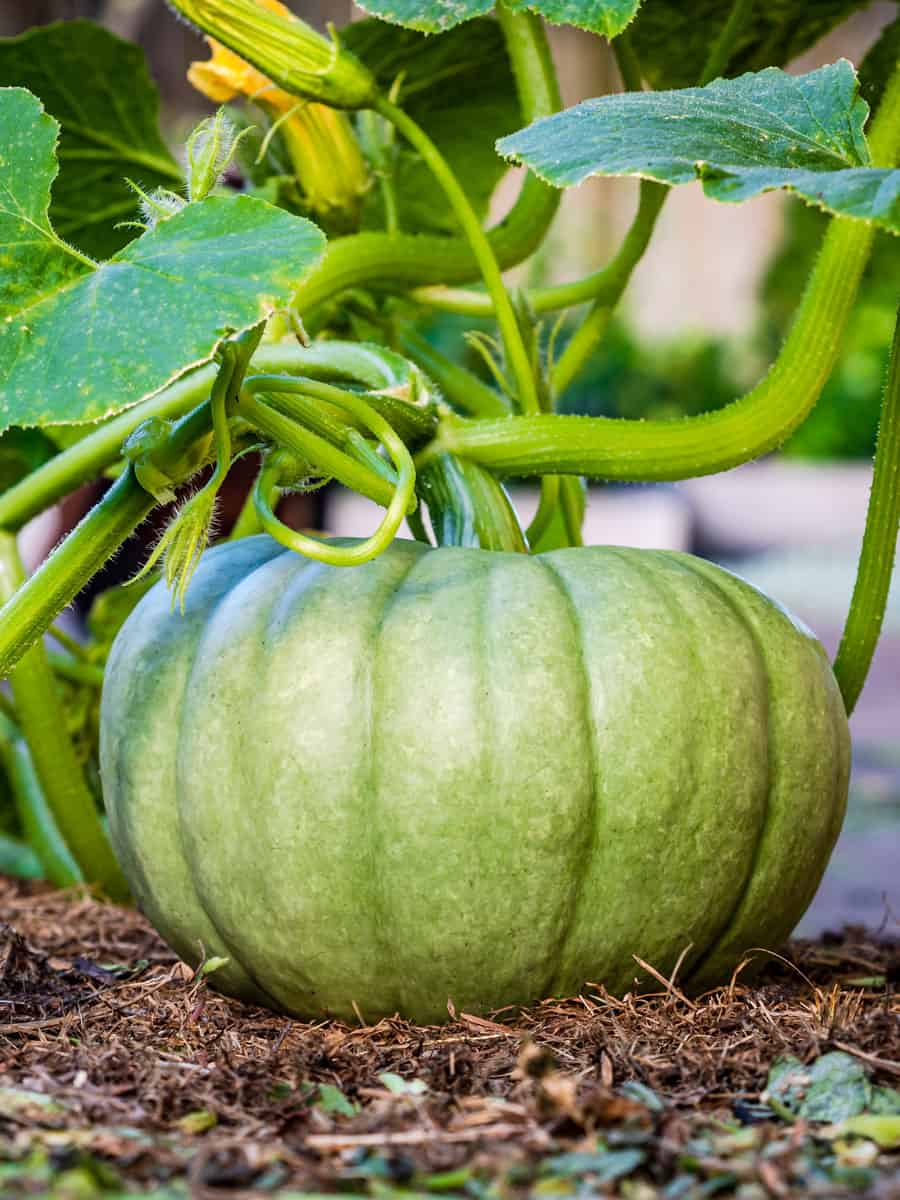
Buttercup squash is a winter squash that has a sweet taste, hence the name Buttercup. They are called turban squashes because of the presence of a cap on the top. It has a thick, green colored skin with deep orange flesh. The buttercup squash is usually 6 inches long and 4 inches wide. This variety of squashes is native to North America. The fruit goes on long vines that are about 24 inches in length. Ripe buttercup squash is a bi-colored fruit with grayish-green colored skin and orange colored flesh.
These squashes grow well in fertile, loose, and well-drained soil, having a pH between 5.5 to 6.5. It needs a soil that is rich in organic matter. It prefers growing in places where sun exposure is full. When planting the seeds, four to five seeds should be planted in a single mound. After the seedlings are produced, the weaker ones are removed for the purpose of thinning out the growth.
Since the flesh of buttercup squash is sweet in taste, it is a popular variety used in many different dishes.
Read more: How to grow buttercup squash
7. Pattypan Squash
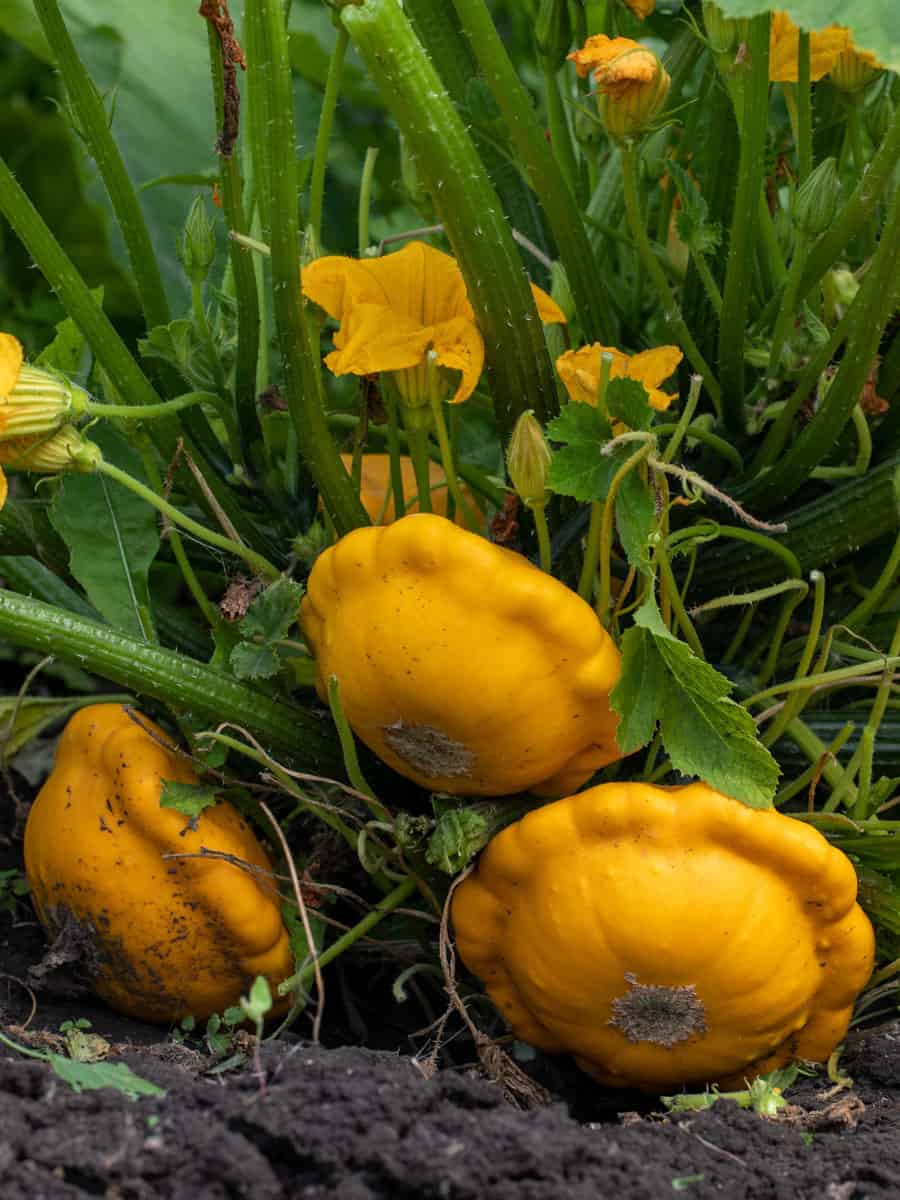
Pattypan squash is also known as Sunburst squash, scallop squash, button squash, and white squash. They are a type of summer squash. It is a native American heirloom squash. They originated as long as 10,000 years ago in Mexico. They are found in green, yellow, and white varieties. They are small in size and are of a shape similar to that of a flying saucer. They grow on vines that spread to about 4 to 6 feet.
They grow best in rich, well-drained soil, under full sun exposure. They are planted in a group of two to three seeds that are planted about 2 to 3 feet apart. Pattypan squash is used in numerous recipes and is also used as a decorative container for some foods.
8. Chayote Squash
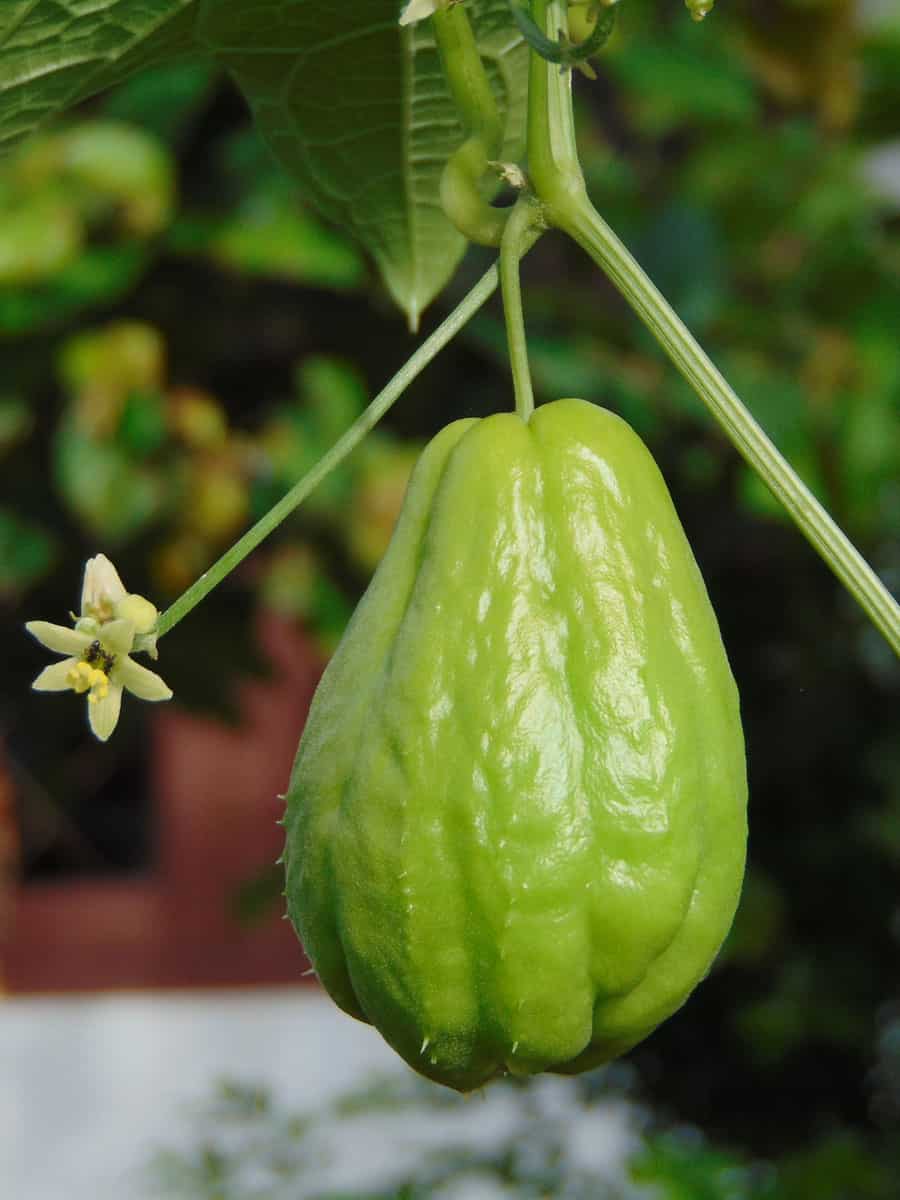
The scientific name of Chayote squash is Sechium edule and is also commonly known as mirliton squash. It is grown in many states of the U.S. including Florida, California, Louisiana, and all over East and South Asia. It is native to Latin America.
It is a perennial vine that has a spreading habit of growth which means it requires plenty of space to spread. The fruit is pale green to white in color and is pear-shaped. Vines can grow to as long as 50 feet.
Chayote squash needs well-drained soil that has adequate moisture retained for the best growth. It requires full sun. However, it can also grow in partial shade but the yield will be lower. The soil pH should be 6.0 to 6.8,
Chayote should be planted when the last frost has passed and the soil has warmed to at least 65 degrees. It gives optimal growth in summers, when the temperature is hot in tropical or subtropical regions like California, Florida, and the Gulf Coast.
Chayote is mostly used cooked lightly to retain its crisp. Raw Chayote squash is also used in salads but this use is not very common. They also have some medicinal importance as they have anti-inflammatory, diuretic, and cardiovascular properties.
9. Gem Squash
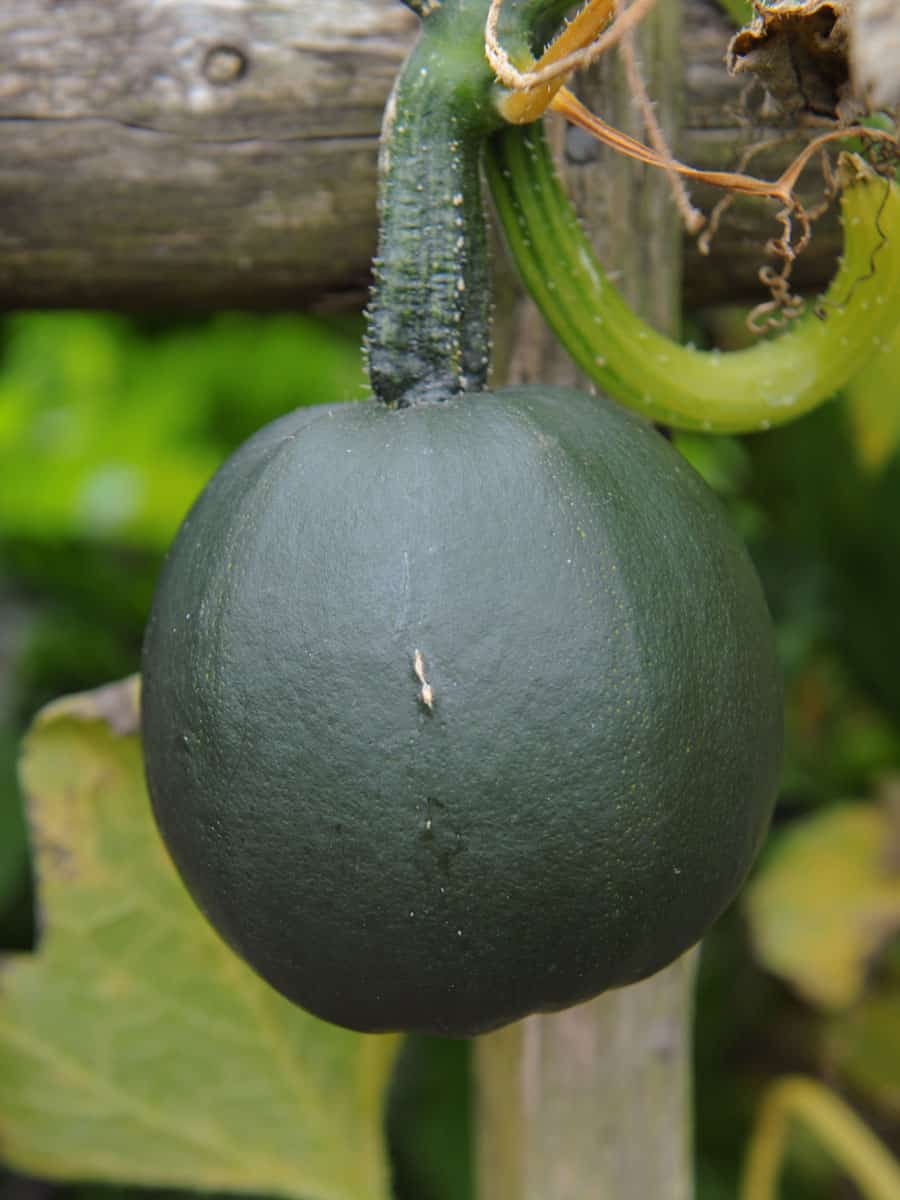
Gem squash is a type of summer squash that has been domesticated form two wild varieties of squashes which are; Cucurbita Texana (native to southern and central United States) and Cucurbita fraterna (native to Mexico). It is a small, dark green colored fruit, having a yellow-green colored flesh. It is so hard that it cannot be eaten raw or half cooked.
Gem squash takes up a lot of space in the growing site as its vines spread wide. They cannot tolerate frost and should be planted when the last frost has passed and the soil has warmed up substantially. It requires a fertile, rich, and well-drained soil. They require full sun exposure for growth, otherwise, they will rot.
Gem squash is served as a boiled or baked vegetable in South Africa. They are cooked after being cut in half due to their hard skin.
10. Red Kuri Squash
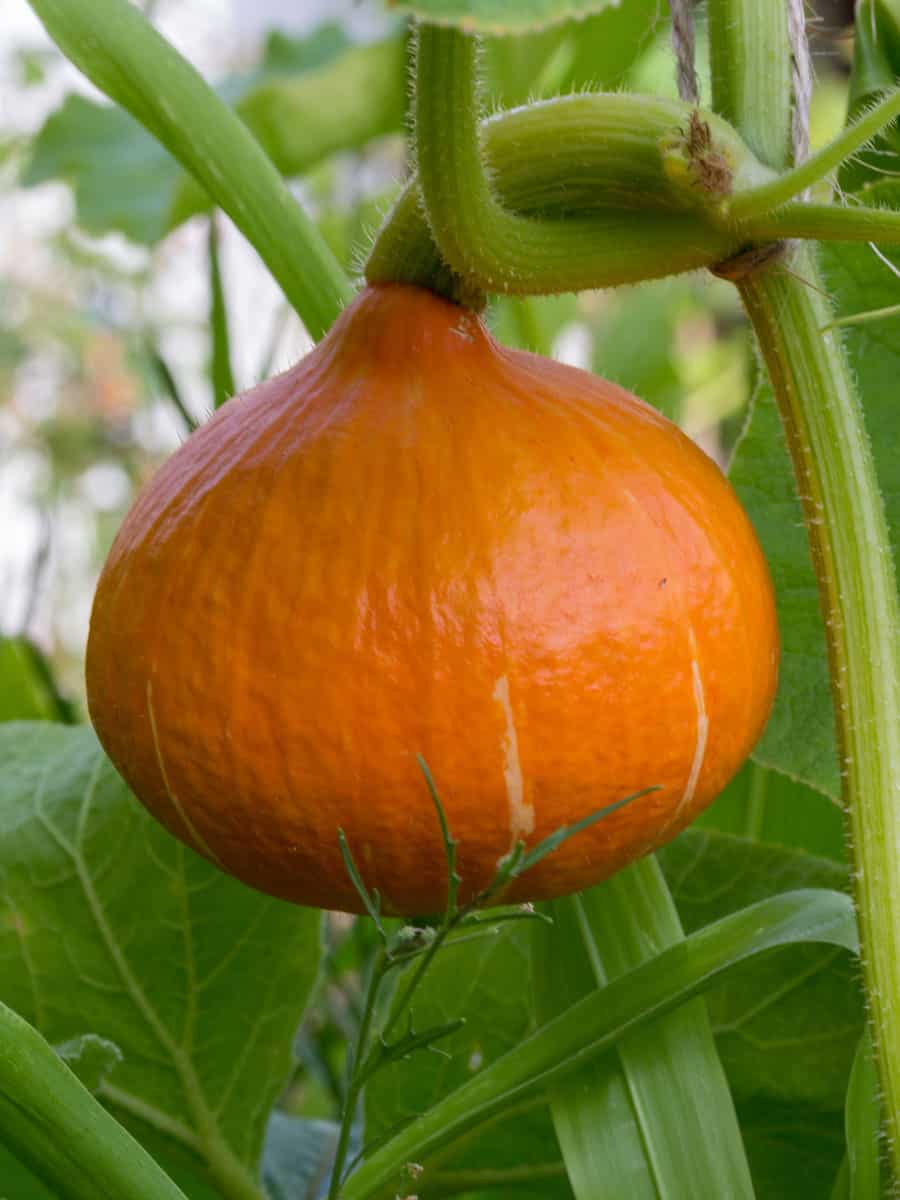
Red Kuri Squash is winter squash that is widely grown in California, Southwestern Colorado, Florida, Tonga, Mexico, Japan, Tasmania, Chile, South Africa, New Zealand, and Provence. It is similar to a small pumpkin in appearance, only without ridges. It is a bright orange colored squash that has a very delicate chestnut-like flavor. The flesh is bright yellow in color.
It is also known as orange Hokkaido squash, Japanese squash, baby hubbard squash, and Uchiki kuri squash. In Japan, the word kuri may refer to squash or Japanese chestnuts. Moreover, it is called potimarron is France, and onion squash in the United Kingdom.
The plant can grow to a height of 8 to 16 inches. They prefer growing in well-drained, rich soil and in areas that have full sun exposure. It is highly frosted sensitive and you should ensure that the last frost has passed before planting them. They love heat and hence, they should be planted when temperatures are fairly warm.
Red kuri squashes are highly nutritious. They are used in a number of recipes including soups, casseroles, and stews.
11. Banana Squash
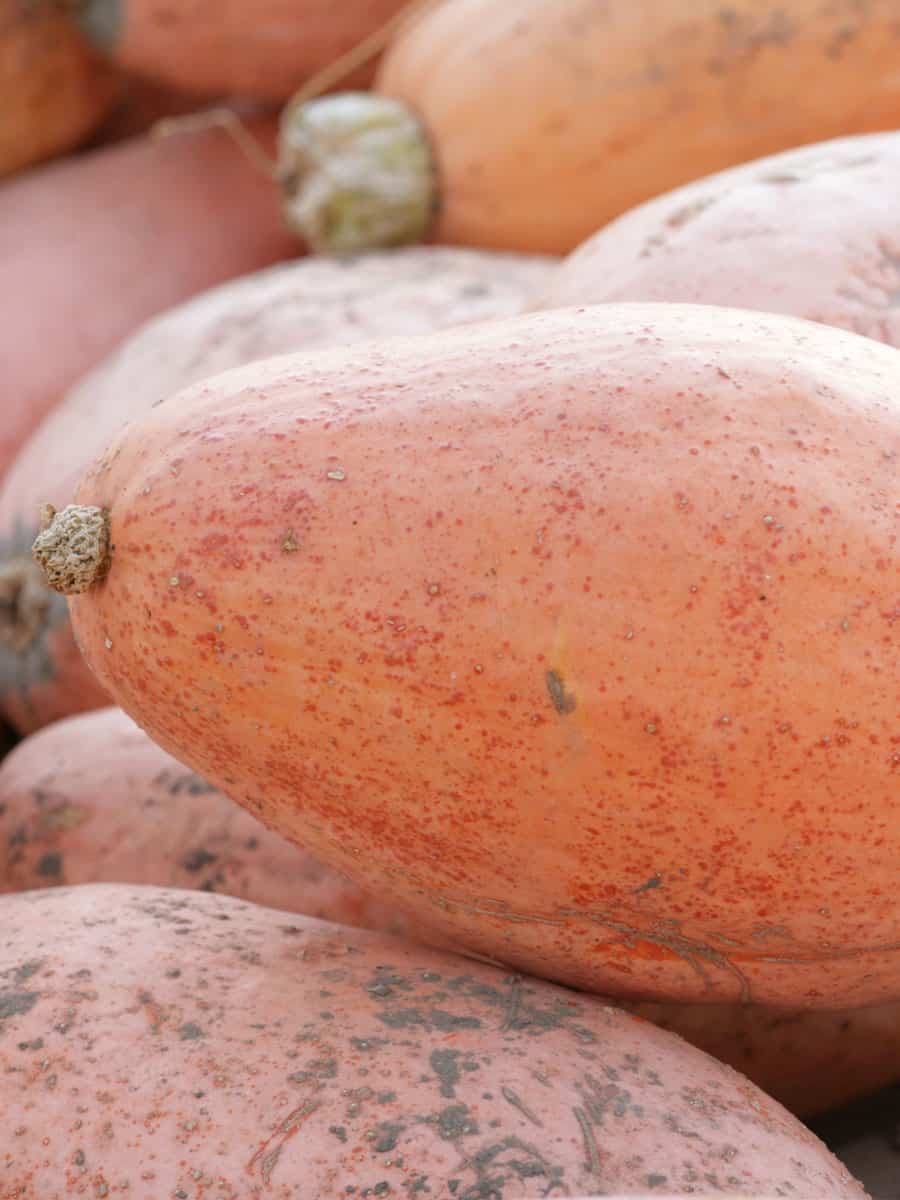
Banana squash is a winter squash variety that is like a large banana in appearance. They can grow very large, with an average size of about 60 to 91 cm in length and 10 to 22cm in width. They are cylindrical and slightly curved in shape. Banana squashes originated in South America. Ever since its introduction, Banana squashes are most popular in western states of North America. Pink banana squash is also called Plymouth Rock or Mexican Banana.
Salmon quashes can be blue, salmon pink, yellow, or variegated in color depending upon the variety with firm orange flesh.
Banana squash needs plenty of space to grow. It grows on vines which can spread to about 12 to 15 feet wide. They require a rich, fertile soil that has considerably warmed to about 65 degrees. The sun exposure should be complete for maximum growth of Banana squashes.
Banana squash mostly has culinary uses. They are eaten steamed, baked, grilled, roasted, baked, or fried. They are usually sliced or cut into rings or cubes and added to stews and soups.
You can buy Banana squash seeds on Amazon.
12. Carnival Squash
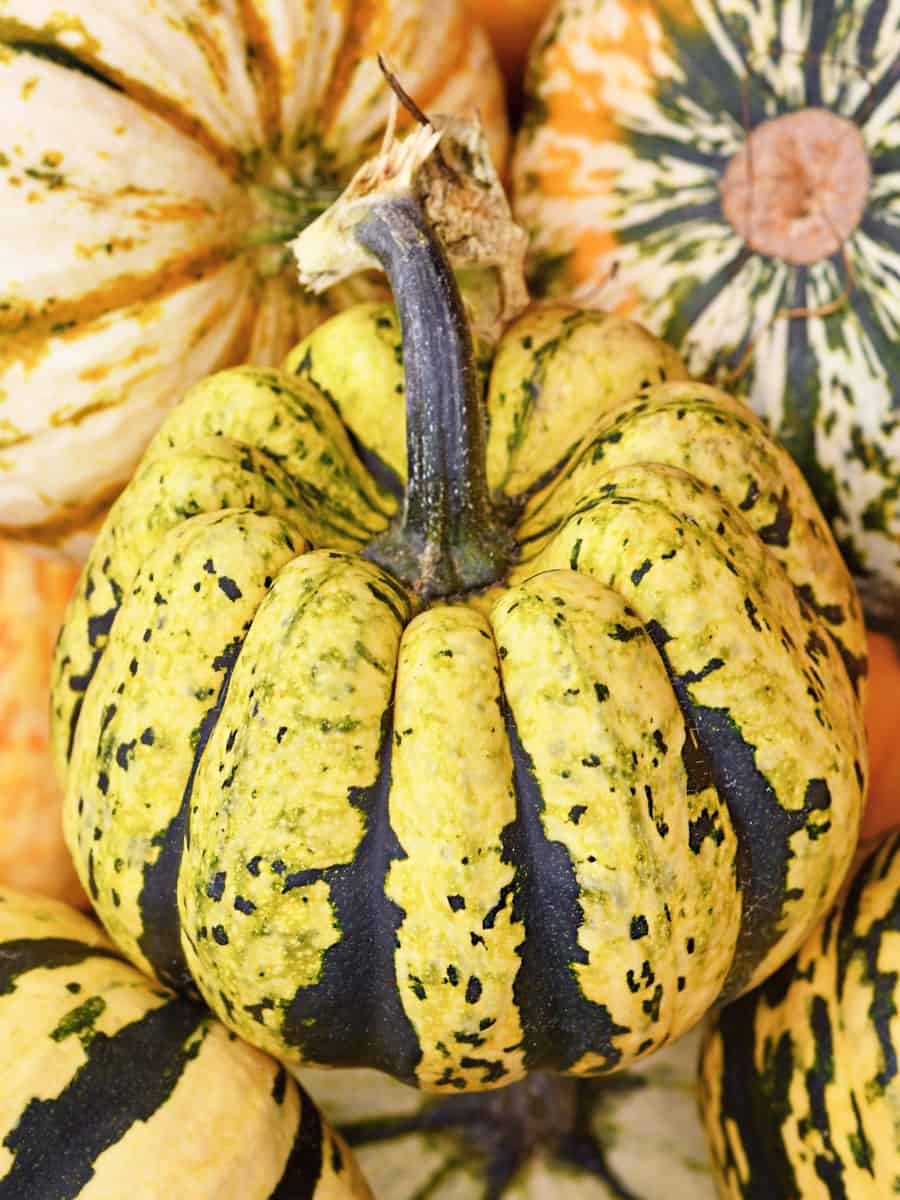
Carnival squash is a colorful acorn squash. The outer skin of a carnival squash is freckled with green, yellow, gold, and white. It is so attractive and eye-catching in appearance that it is used for decorative purposes. However, carnival squashes are not just used for decorations. Their taste improves upon storage which makes a great squash to be used in a variety of recipes.
They are summer-loving squashes and like other squash varieties, they should be planted when the last frost of the season has passed. The seeds should be planted in warm soil which has a temperature of at least 70 degrees. They require a well-maintained, well-watered, and fertile soil for maximum growth.
A ripe carnival squash has very hard skin, so much that you can tell it’s fully ripe when you cannot prick it with your fingernail.
You can buy Carnival squash seeds on Amazon.
13. Patidou Squash
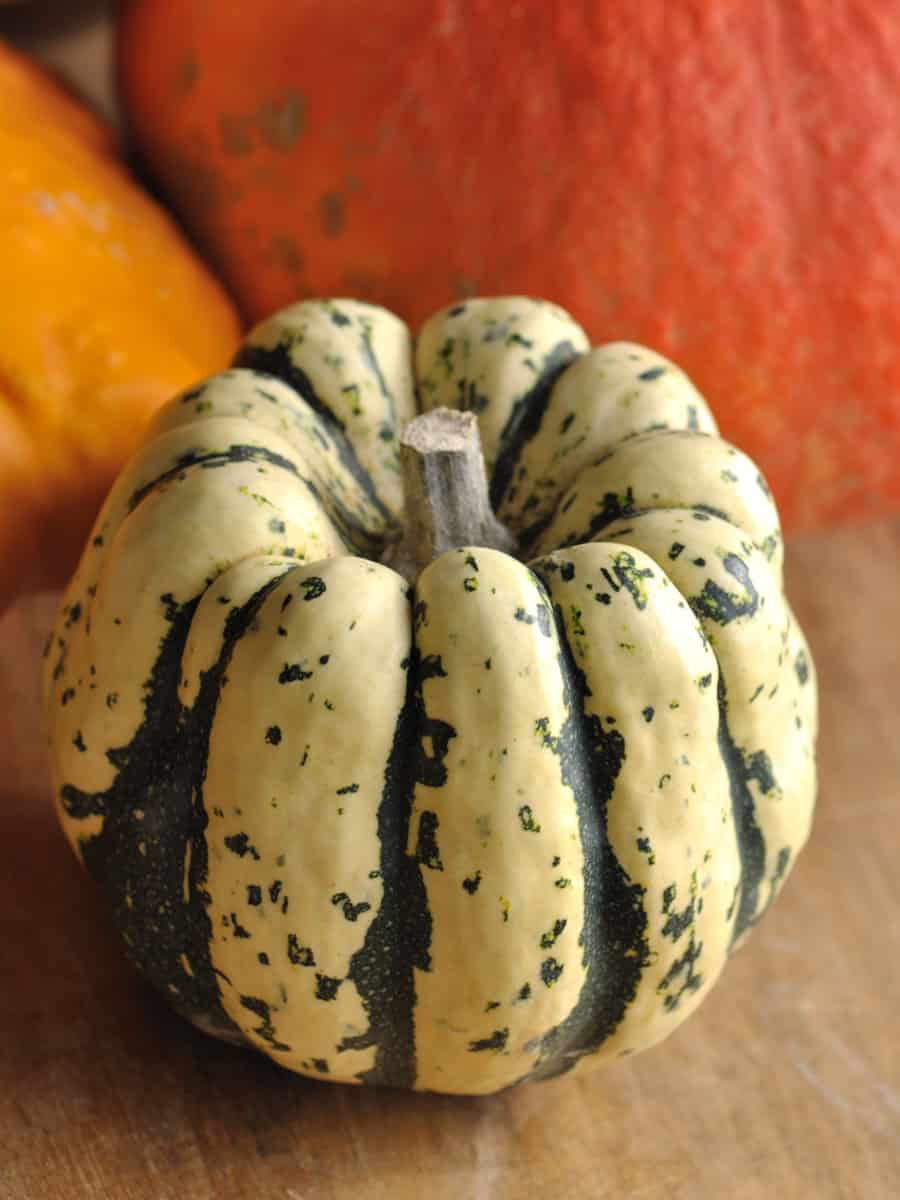
Patidou squash is more commonly known as the sweet dumpling squash. It is a smaller, winter variety of squashes. It grows to an average of 4 inches in diameter. The skin of sweet dumpling squash is usually white with yellow, green, and orange markings. Bold, hollow, and scalloped lobes make the outer surface of these squashes. The flesh is orange in color and rather smooth in texture.
Sweet dumpling squashes are vigorously growing squashes that spread rapidly. The vines of sweet dumpling squashes are not as long as other varieties. They need a well-drained and rich soil that has moderate moisture.
Since they love warm weather, they can be grown in a tropical, subtropical, temperate, and Mediterranean dessert climate. They can be grown in regions in hardiness zones 4 or more. The water requirement is average. However, they need full sun for best growth.
You can buy Patidou seeds on Amazon.
14. Turban Squash
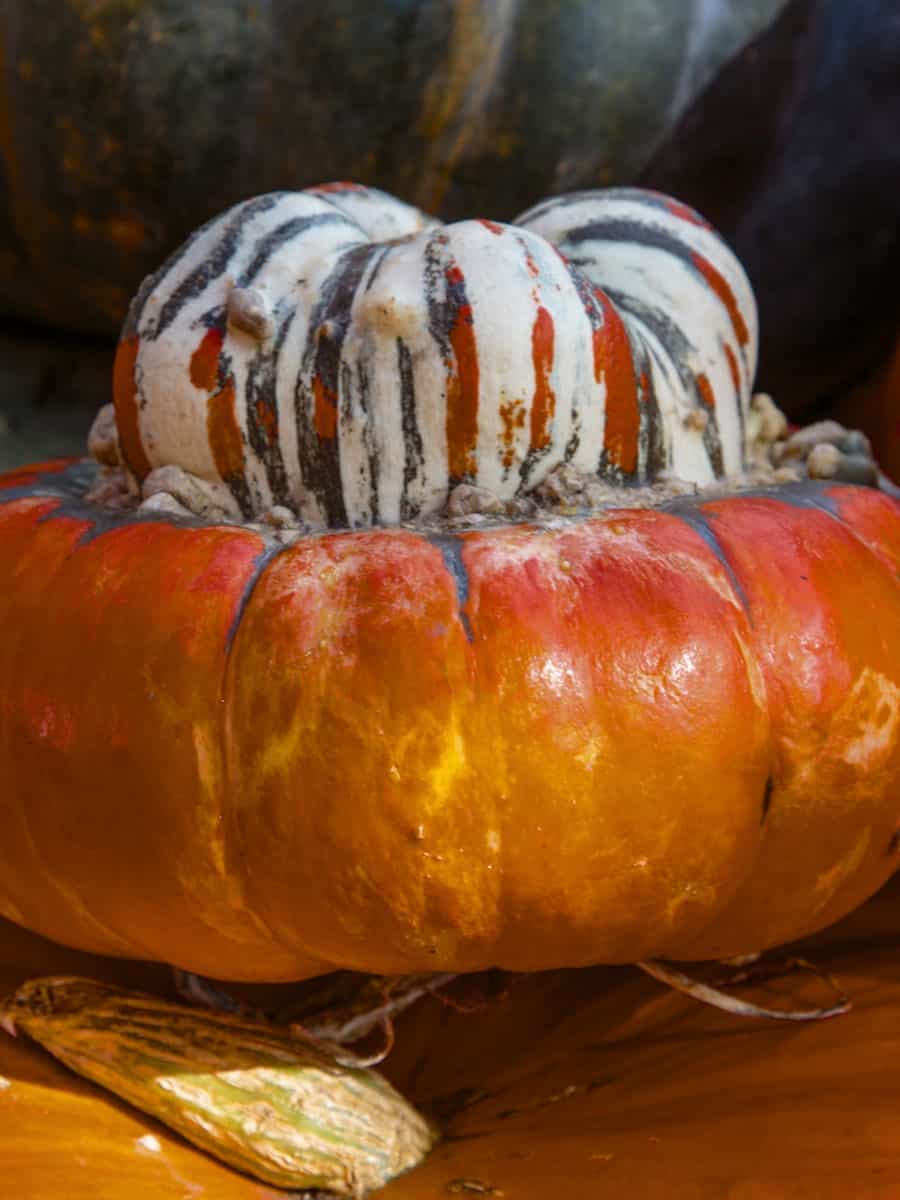
Turban squash, or Turk’s turban, or French turban (Giraumon) is one of the most attractive of all squashes. They are brightly colored fruits that are found in different colors. Their lower bodies are usually a single color, orange or reddish-orange while the upper turban or the upper body is beige with streaks in dark green and reddish-orange colors. Other common names of this squash are Turk’s cap and Mexican Hat.
Turban squashes are Heirloom. As much as they look like something from outer space, they actually originated in Central and North America. They are mostly used for ornamental purposes, owing to their remarkable colors and shape. However, they also taste wonderful hence they are also used in numerous recipes.
These plants should be grown in full sun. They also require a very rich soil that should also be well-drained. For the best growth of Turban squashes, the soil needs to be treated with fertilizer regularly. They require a lot of maintenance, with regular watering. The soil has to be kept moist but not wet. If they are not watered adequately, the fruit may ripen prematurely.
You can buy Turban squash seeds on Amazon.
Read more: How to grow turban squash
15. Kabocha Squash
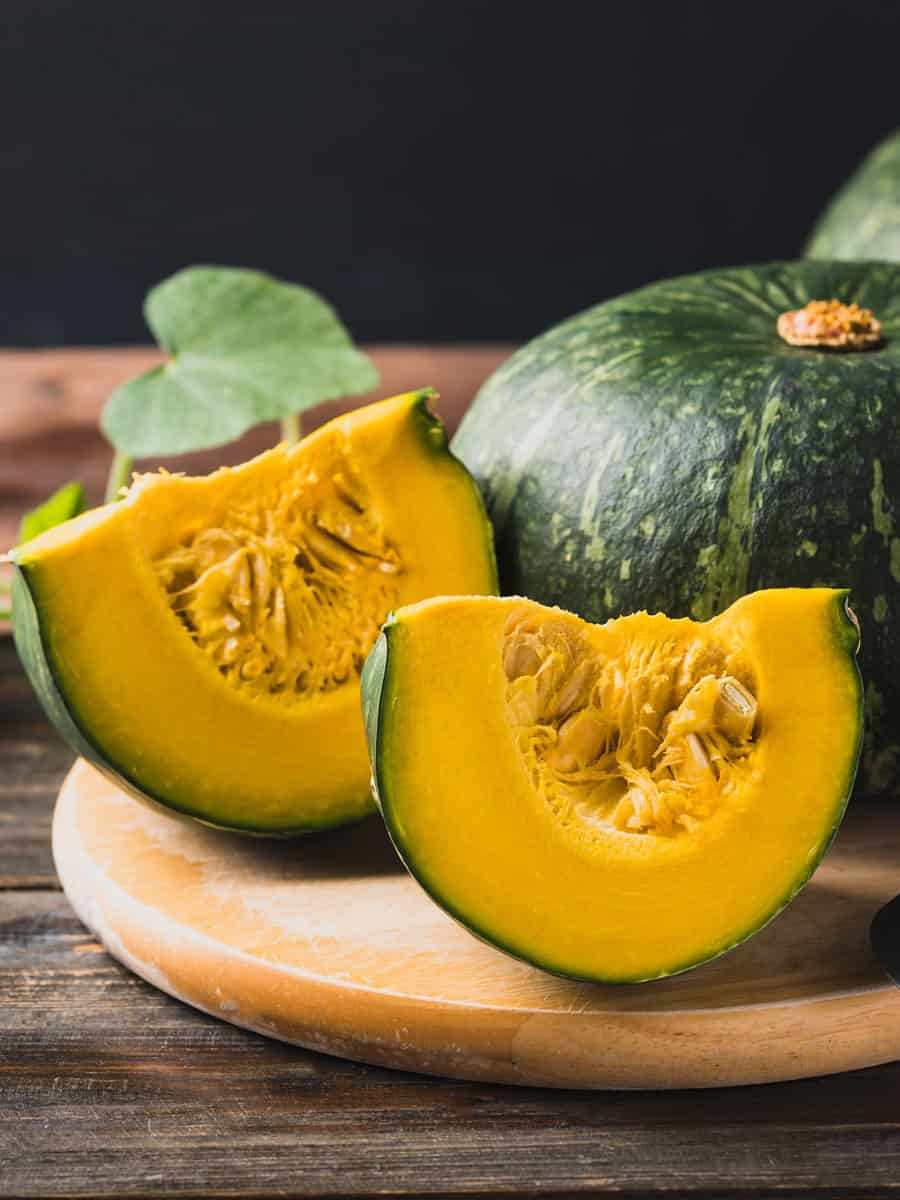
Kabocha squash is a Japanese variety of winter squashes. In Japan, Kabocha could mean this squash, a western pumpkin, or any other squash. They are similar to pumpkins in shape. They have a hard, knobbly looking skin that has a dull finish. The skin is dark green in color with celadon-to-white stripes. The flesh of kabocha squash is an intense shade of yellow-orange.
Kabocha squashes are primarily grown in South Korea, Japan, Thailand, Hawaii, Florida, California, Mexico, Tongo, Southwestern Colorado, Tasmania, New Zealand, Jamaica, Chile, and South Africa.
They need full sun exposure for growth. The garden should receive at least 6 hours of sunlight during the day. They grow best in fertile, well-drained soil. They need to be watered once a week. They will rot if waterlogging occurs, therefore the soil should be well-drained and not too wet. The soil pH should be 6.0 to 6.5.
Kabocha squashes are sweeter than the butternut squashes. The texture of the flesh is similar to a pumpkin and sweet potato. Kabocha is more commonly used in recipes of side dishes like soups.
You can buy Kabocha squash seeds on Amazon.
Read more: How to Grow Kabocha Squash
16. Round Zucchini
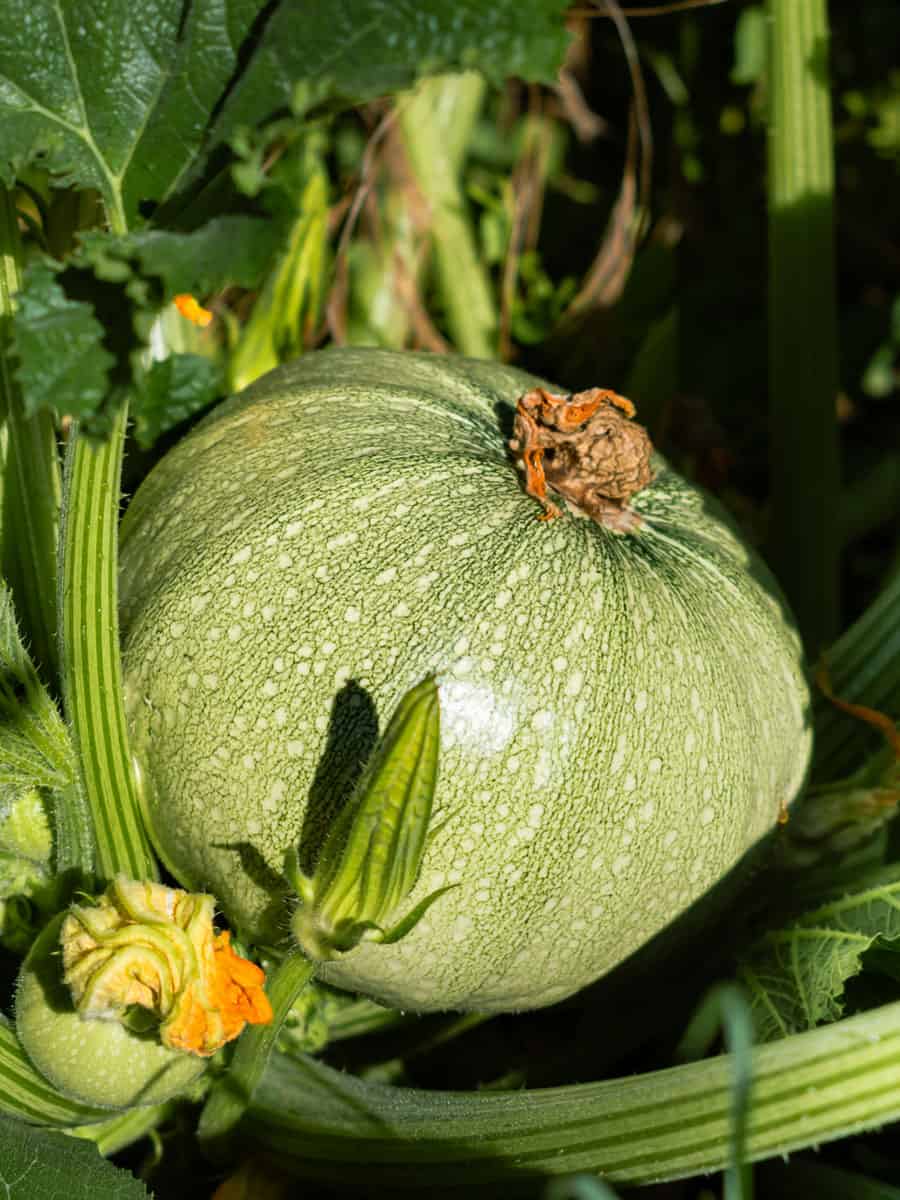
Round zucchini is a zucchini variety that is unusually shaped. Unlike the elongated zucchini, a round zucchini is fairly small and round in size. It has a richer and sweeter taste compared to its elongated cousin. They are quite easy to grow. The round zucchini has a dark green colored skin with pale yellow flesh.
These squashes require rich, fertile, and well-drained soil for optimum growth. The soil should be moderately moist. The fruits taste best when they are still very small. Moreover, plucking young fruits promotes continued production. They grow in warm weather, therefore, the seeds should be planted in late spring.
Round zucchini can be used in salad or it can be baked or stir-fried. It works great for stuffed zucchini recipes because of its round shape.
You can buy Round zucchini seeds on Amazon.
17. Yellow Summer Squash
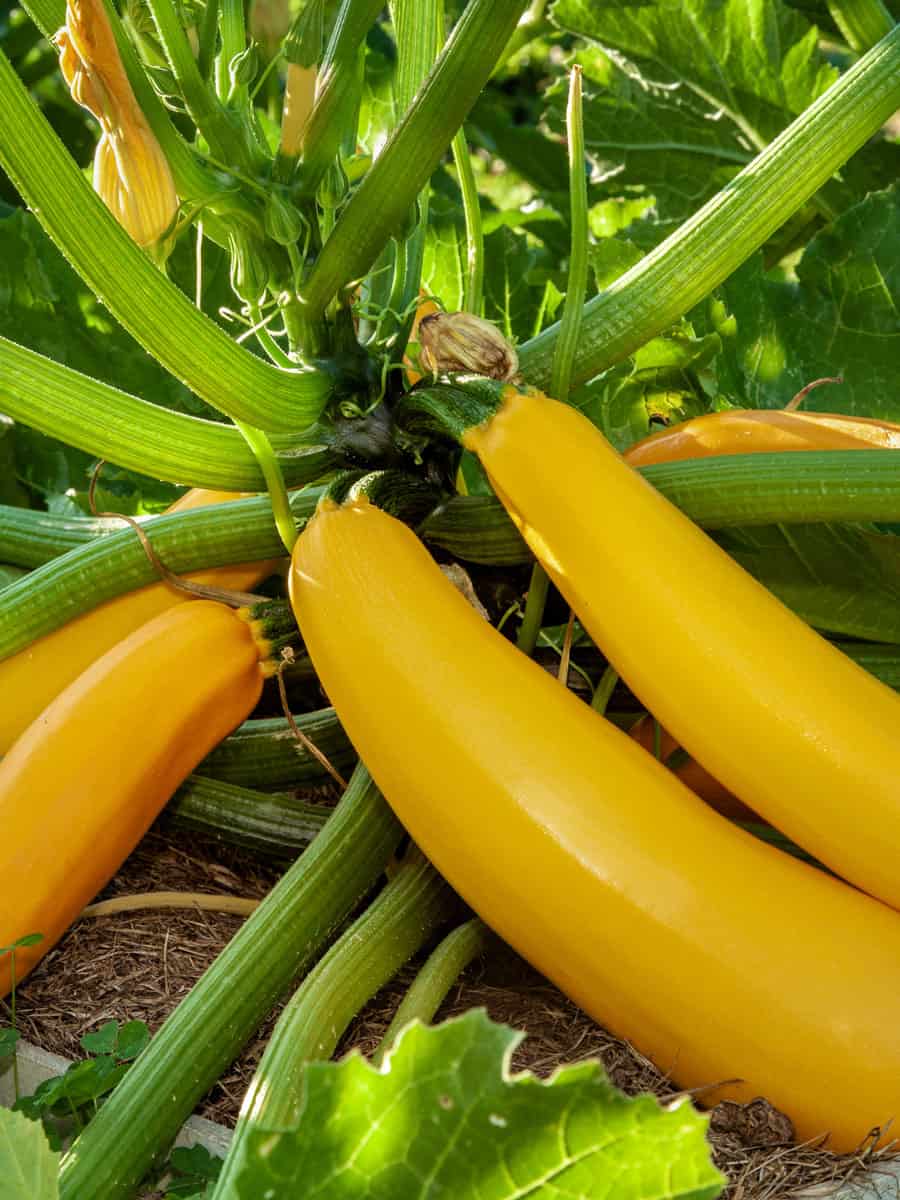
Yellow summer squash is a summer variety that is bright yellow in color. Unlike winter squashes, the yellow summer squashes do not spread vigorously. They are bushy plants that produce fruit within 7 weeks of planting. They are easy to grow. The best thing about these squashes is that the more you pluck them out, the more fruit they will produce.
They come in various shapes and sizes and all of them taste best when they are young and tender. Like all other squashes, these squashes are summer loving. The seeds should be planted when the last frost has passed and the soil has become warmer. Yellow summer squashes require full sun, rich, and consistently moist soil for best growth.
They are used mostly for culinary purposes.
You can buy Yellow summer squash seeds on Amazon.
18. Cousa Squash

Cousa squash is a summer squash variety that is similar to zucchini in taste. It has a light green colored skin. They require a very fertile soil that is rich in compost and manure. The soil should be well-watered. The seeds of Cousa squash should be planted in warmer seasons when the temperature of the soil is at least 70 degrees.
It is used just like zucchini. Its origin lies in the Middle East. It is very popular in Syrian and Lebanese recipes.
You can buy Cousa squash seeds on Amazon.
19. Tromboncino Squash
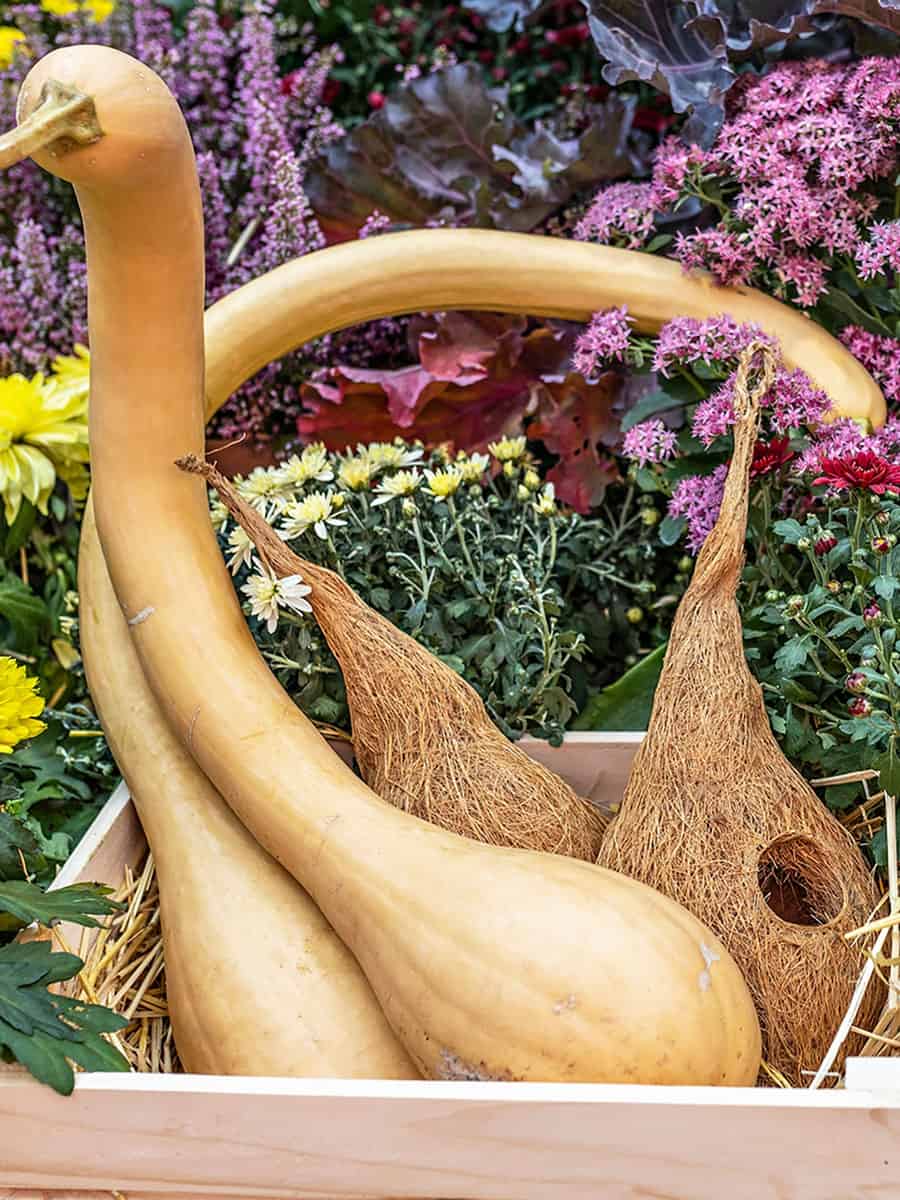
Other common names of Tromboncino squash are zucchetta rampicante, climbing crookneck, climbing zucchini, serpentine squash, trombetta, and trombolino d'albenga. It is used as a summer squash most often. However, it has a vining growth habit which is unlike other summer squashes and very much like winter squashes.
Trombincino squash is an heirloom that originally belongs to Liguria but is still popular all over Italy and other parts of the world.
The color of the fruit is pale green which fades to beige when the fruit matures. It is plucked from the plant when it is one foot long. However, if left to grow further, they can grow o become as big as 3 feet long. These squashes are used in many recipes.
They are not winter-hardy and grow best in warm weather. They need full sun exposure for maximum growth. Seeds should be sowed when the soil is warm. The ideal pH for their growth is 6.0 to 6.8.
You can buy Tromboncino squash seeds on Amazon.
20. Zephyr Squash
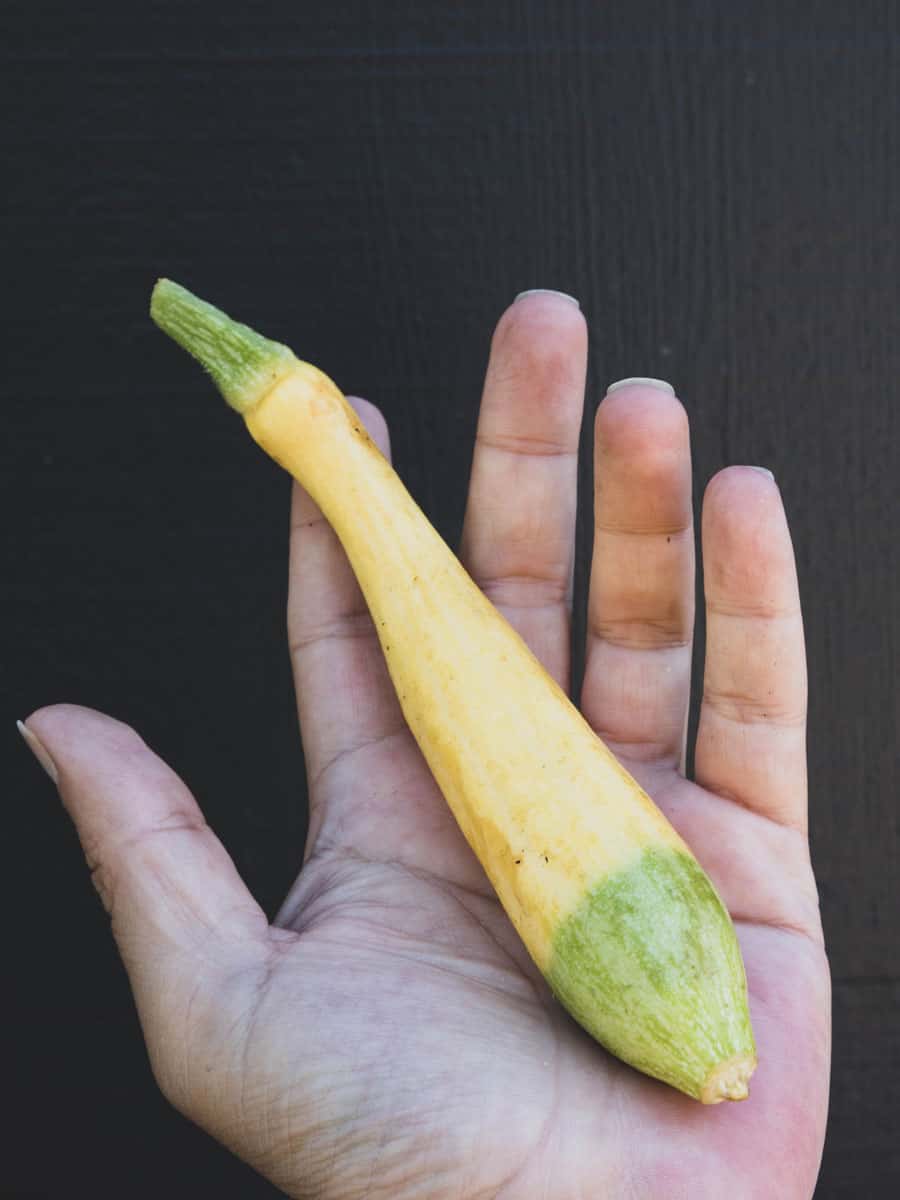
Zephyr squash is one of a kind squash. It carries genes of delicate, acorn, and crookneck species. A zephyr squash is a cross between yellow crookneck species and a hybrid of yellow Acorn squash and Delicata squash. Its neck is crooked to about 5 to 8 inches. It is pale green at the blossom end and yellow at the stem end. Faint white lines run longitudinally across its length.
It has an open habit of growth. Like all other varieties of squashes, a Zephyr squash is also a warm season hybrid. The seeds should be sowed when the climate and the temperature of the soil are warm. They need regular fertilizing and watering for best growth. Once the fruit is produced, it should be harvested a few times during the week.
Zephyr squashes can be used raw or cooked. You can eat it boiled, sautéed, steamed, or fried (pan-fried or deep-fried).
You can buy Zephyr squash seeds on Amazon.
21. Ambercup Squash
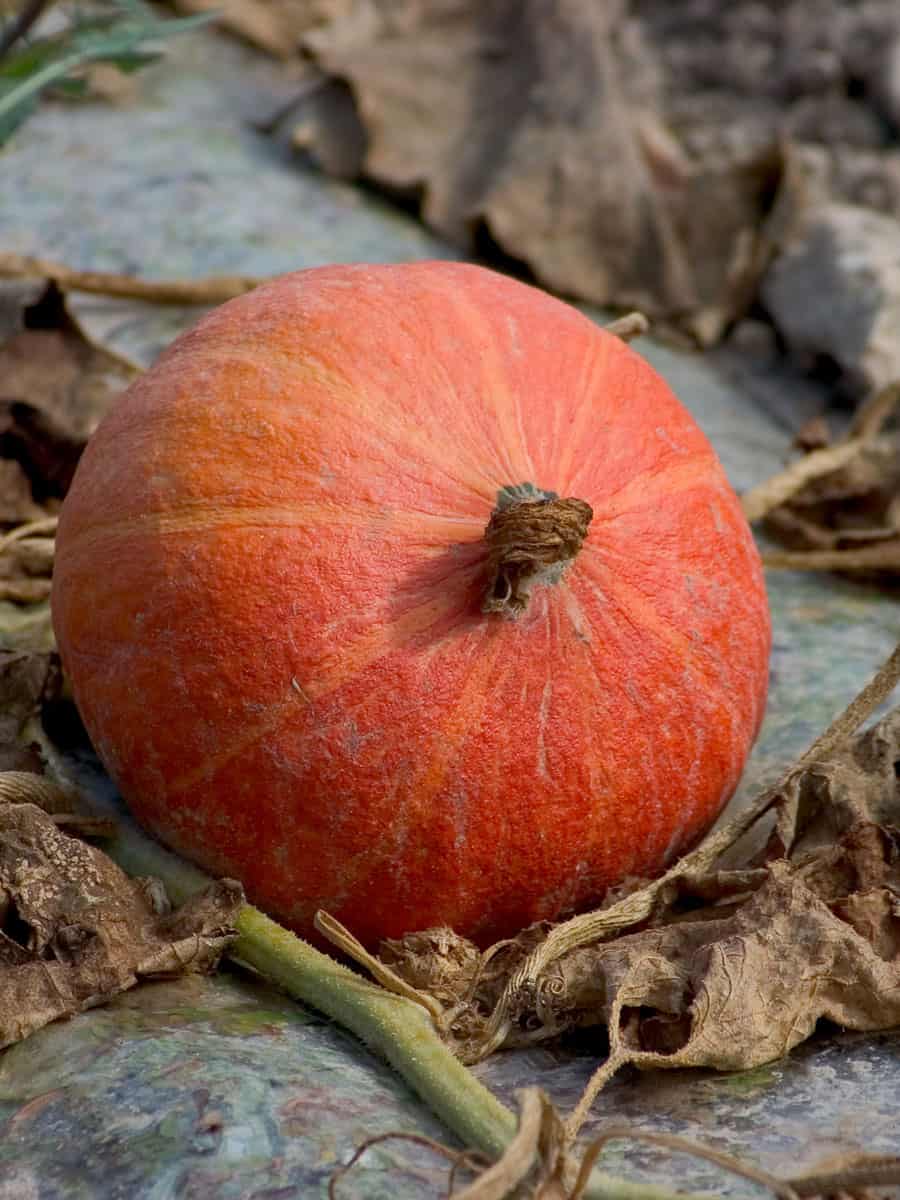
Ambercup squash is closely related to buttercup squash. You can call these two squashes relatives. It is quite small in size, resembling a small pumpkin. It has an orange colored skin and an even brighter orange-colored flesh. Tan blotches can be seen on its surface along with slightly indented ribs.
Ambercup squashes can grow to about 20cm in width and 12.5cm in height. These squashes grow on vines and spread rapidly.
They are mostly eaten fried. Ambercup squashes have an amazing texture and taste, having no stringiness. The sweet and mild flavor and the gorgeous color make it a popular type of edible squash.
Being closely related to buttercup squashes, its growth requirements and maintenance is also similar to that of buttercup squash.
22. Crookneck Squash
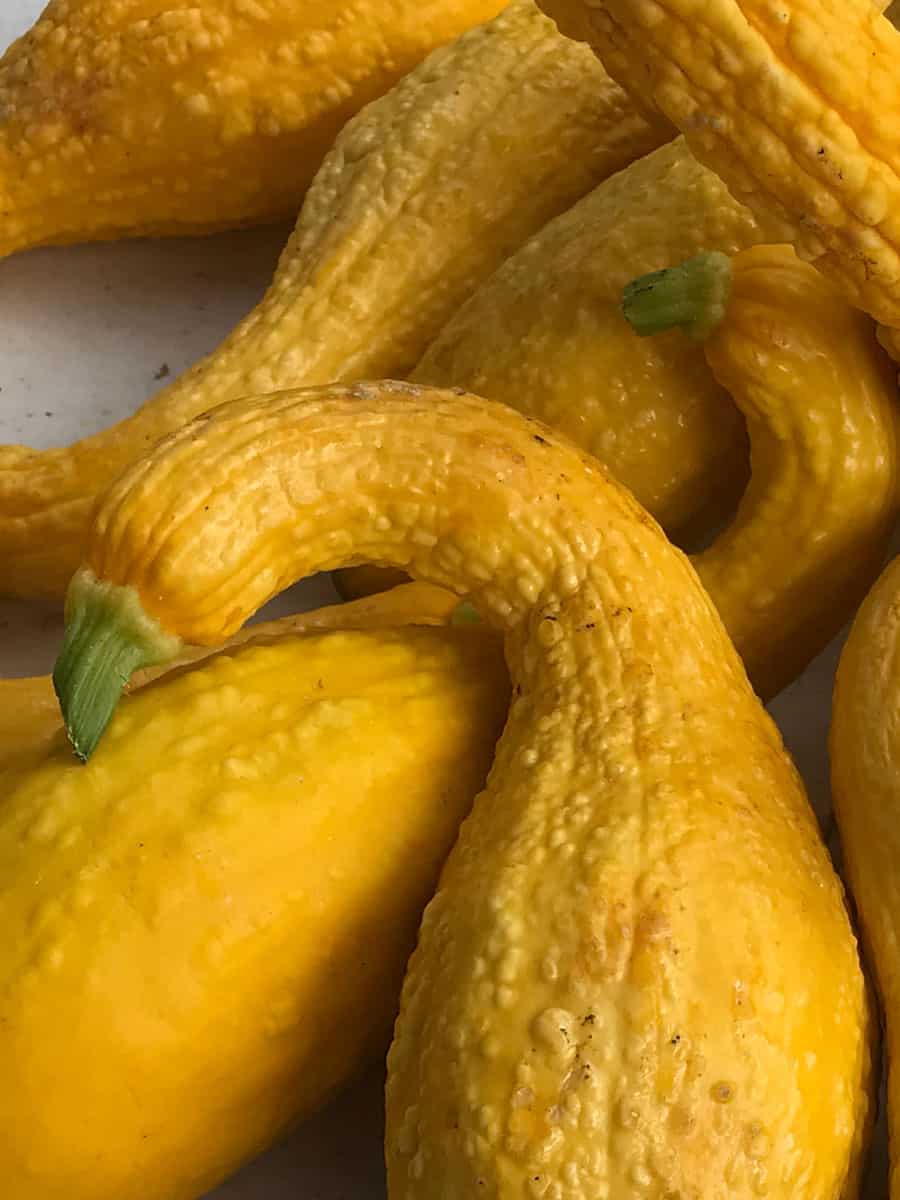
A Crookneck squash is a summer squash variety that does not grow long, spreading vines. It is a bushy plant with leaves as wide as 1 to 2 feet wide. It has an upright growth habit. The fruit sets at the base of the plant. It has a sweet, buttery taste that makes it a popular type of squash for various dishes. The fruit is usually 4 to 6 inches in length and 1 to 2 inches in diameter. The skin is bright yellow color and the flesh is cream in color and bumpy in texture.
Bring a summer loving squash variety, they are found commonly in regions that have long and warm summers.
Crookneck squash requires at least 6 to 8 hours of full sun exposure. There, they should be planted in sunny areas. Although it does not take up a lot of ground space, the broad leaves are enough to take up as much space as 3 to 4 feet. It requires a rich soil that should be treated with plenty of compost when planting.
You can buy Crookneck squash seeds on Amazon.
23. Calabaza Pumpkin
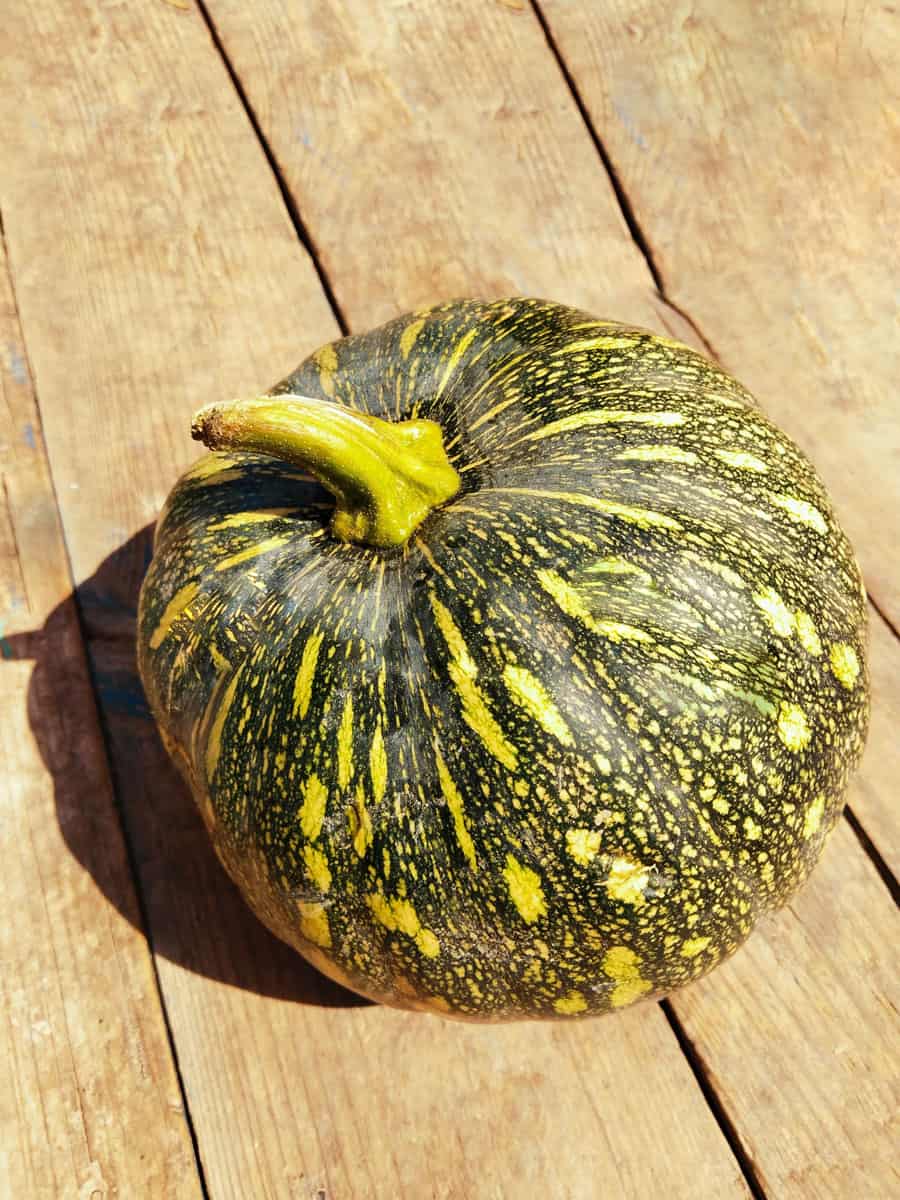
Calabaza pumpkin is a winter squash. It is also known as calabassa or the West Indian Pumpkin. It is most commonly grown in tropical America, West Indies, and the Philippines. In Florida, Philippines, and Puerto Rico, Calabaza is a common name for Curcubita moschata. Curcubita moschata is known as ayote in Central America, auyama in Dominican Republic, zapaito in South America, and Calabash or squash in all English-speaking islands.
The word calabaza has been derived from melon (kharbuz) which is a Persian word. The French term is calabasse. Hence the English word, calabash.
This plant has long vines which can grow to become as long as 15m. The fruit may be oblate, oval, obovate, spheroid, or elliptic. The color of the rind varies from dark green to light orange when it starts to mature. The flesh is green-yellow or orange in color.
Calabaza pumpkin requires very fertile soil to grow. The soil should be fertilized and treated with compost prior to planting. Like other winter squash varieties, it requires full sun exposure for maximum growth.
Calabaza pumpkin can be used in various recipes like soups, cakes, and even candies because of its smooth and sweet taste.
24. Waltham Butternut Squash

Waltham butternut squash is a winter squash. It is butternut squash with a more profound taste, improved uniformity, and better yields. The plant spreads to about 48 to 60 inches. Waltham butternut squash fruit is typically 12 to 15 inches long, weighing around 6 pounds. The outer skin is usually a pale orange color with a bright orange colored flesh.
Waltham butternut squash needs full sun exposure for maximum growth. The soil should be rich and very fertile. Moreover, the seeds should be planted when the climate is warmer and the temperature of the soil is also high. Since squashes take up a lot of nutrients from the soil, they should be planted in areas where o squash varieties have been grown for at least 2 years.
Waltham butternut squash is used in many recipes such as soups, pies, muffins, casseroles, and bread.
You can buy Waltham butternut squash seeds on Amazon.
Read more: When and How to Harvest Butternut Squash
25. Cocozelle Squash

Cocozelle squash is a summer squash. It is an Italian heirloom. The fruit is light green in color with dark green stripes. Cocozelle squash has a pleasant nutty flavor that makes it a commonly used culinary squash. It is perfect for steaming, frying, canning, and freezing. The size of the fruit is usually 5 to 7 inches. It falls in hardiness zones of 3 to 11.
It requires warm to hot temperatures to grow. The seeds should be planted when there are no chances of any more frost. The soil temperature should be 70 degrees when the seeds are planted. The Cocozelle squash should be planted in areas that receive at least 6 hours of direct, hot sunlight. Cocozelle squashes are heavy feeders hence they require a very rich and fertile soil for best growth.
They have a spreading growth habit, therefore, they take up a lot of space and are not suitable for small gardens.
You can buy Cocozelle squash seeds on Amazon.
26. Luffa Squash

Loofah sponge that you use at home comes from none other than the Luffa squash. Luffa is also known as Loofah or loofah. It refers to two species of gourd: Luffa aegyptiaca and Luffa cyclindrica. It is quite popular in China and Vietnam.
Luffa aegyptiaca is also called angled luffa, Chinese Okra, ridged luffa, or vegetable gourd). Luffa cylindrica is also known as smooth luffa, dishrag gourd, Egyptian luffa, or gourd loofa. Angled luffa has ridges that run along the entire length while smooth luffa has a round profile.
Luffa species have a vining growth habit that grows vigorously. They are considered cousins of squashes.
They prefer growing in moist, but well-drained soil, in areas that receive full sun. the soil should be rich in compost and manure. They are not suitable for small gardens because of their rapidly growing long vines.
The luffa squash has green skin with spongy, light-brown colored interior. They are used to make sponges and loofahs. Dried fiber from luffa can also be used to make table mats, filters, sandals, and similar other products.
You can buy Luffa squash seeds on Amazon.
27. Table Queen Squash
Table Queen squash is an heirloom acorn squash that has a dark green rind and a yellow colored flesh. The flesh turns orange upon storage. The skin of the fruit is ribbed. Table queen squash fruit is usually 6 inches long.
Table Queen squash has a vining growth habit. It grows to a height of 10 to 12 inches and can spread 48 to 60 inches wide. Like all other varieties of squash that have been discussed, these squashes also need warm weather to grow. They need full sun exposure for the best growth, along with highly fertile soil. They are heavy feeders hence soil has to be rich in compost and manure. The best area to plant these squashes is where no other squash varieties have been grown for at least 2 years.
Table Queen squash has a sweet taste that makes it a common squash used in culinary.
You can buy Table Queen squash seeds on Amazon.
28. Tatuma Squash
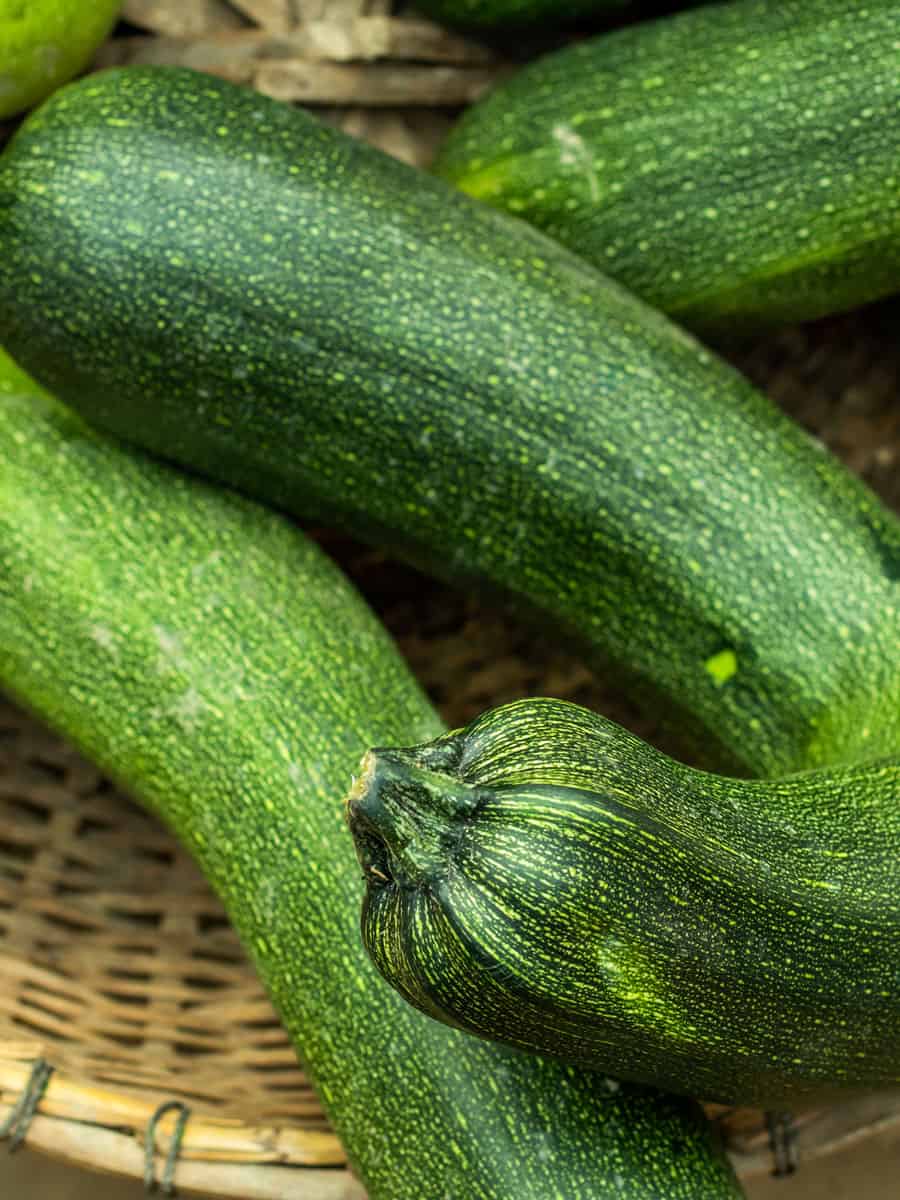
Tatuma squash, also known as Tatume squash of White Mexican Squash is a popular Mexican variety. It looks like zucchini but its sweeter in taste and fairly larger. The skin is dark green in color with even darker longitudinal stripes running along its length. It may be round or oblong. The flesh of Tatuma squash is whiter than that of Zucchini.
Tatuma squash requires a rich soil that is rich in compost, well-rotted manure, or fertilizer. Full sun exposure is required for the growth of these squashes.
Tatuma squash is one of the most popular squash varieties that are used in Mexican dishes.
You can buy Tatuma squash seeds on WestWind Seeds and Gardenscapes.
Click here to buy Tatauma squash seeds on West Wind Seeds.
29. Straightneck Squash
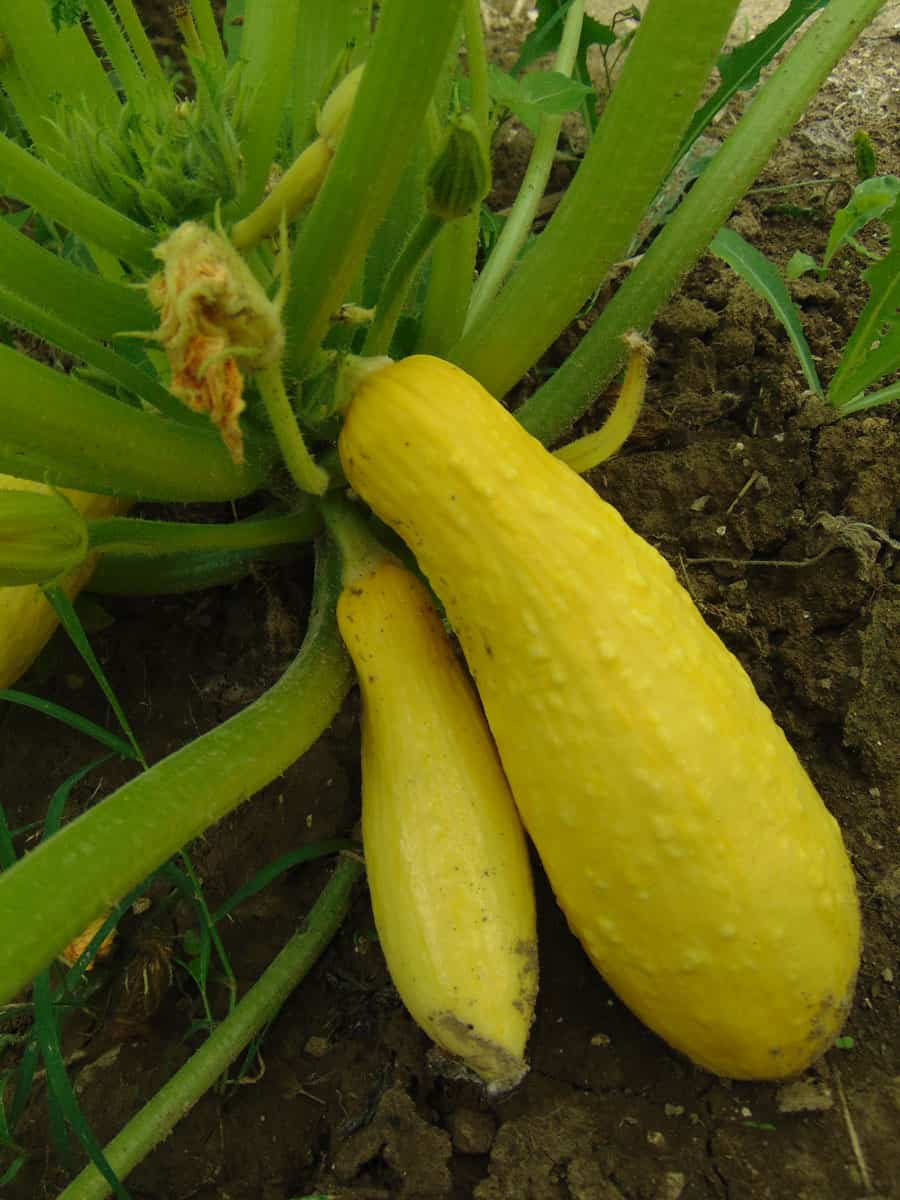
Straightneck squash is a variety of Yellow Summer squash. They bear yellow colored fruits that have a tapered neck.
The Straightneck squashes prefer a soil that is rich in humus and is well-drained. The pH range of the soil that is suitable for the growth of Straightneck squash is 6.0 to 6.5. They require plenty of sunlight for growth and thrive best in areas that receive at least 6 to 8 hours of sunlight every day.
The seeds of Straightneck squash would not germinate if the temperature of the soil is lower than 60 degrees. They are summer loving squashes and hence they need warmer temperatures o grow. The soil should be kept moist but not too wet until the germination of seeds occurs. They are high maintenance squashes that need to be watered twice a week.
They have a subtle taste. They can be eaten raw or cooked. It can be sliced and layered in lasagna or can be added into salads. It is a versatile fruit that can be used in any way you like.
You can buy Straightneck squash seeds on Amazon
30. Eight Ball Squash
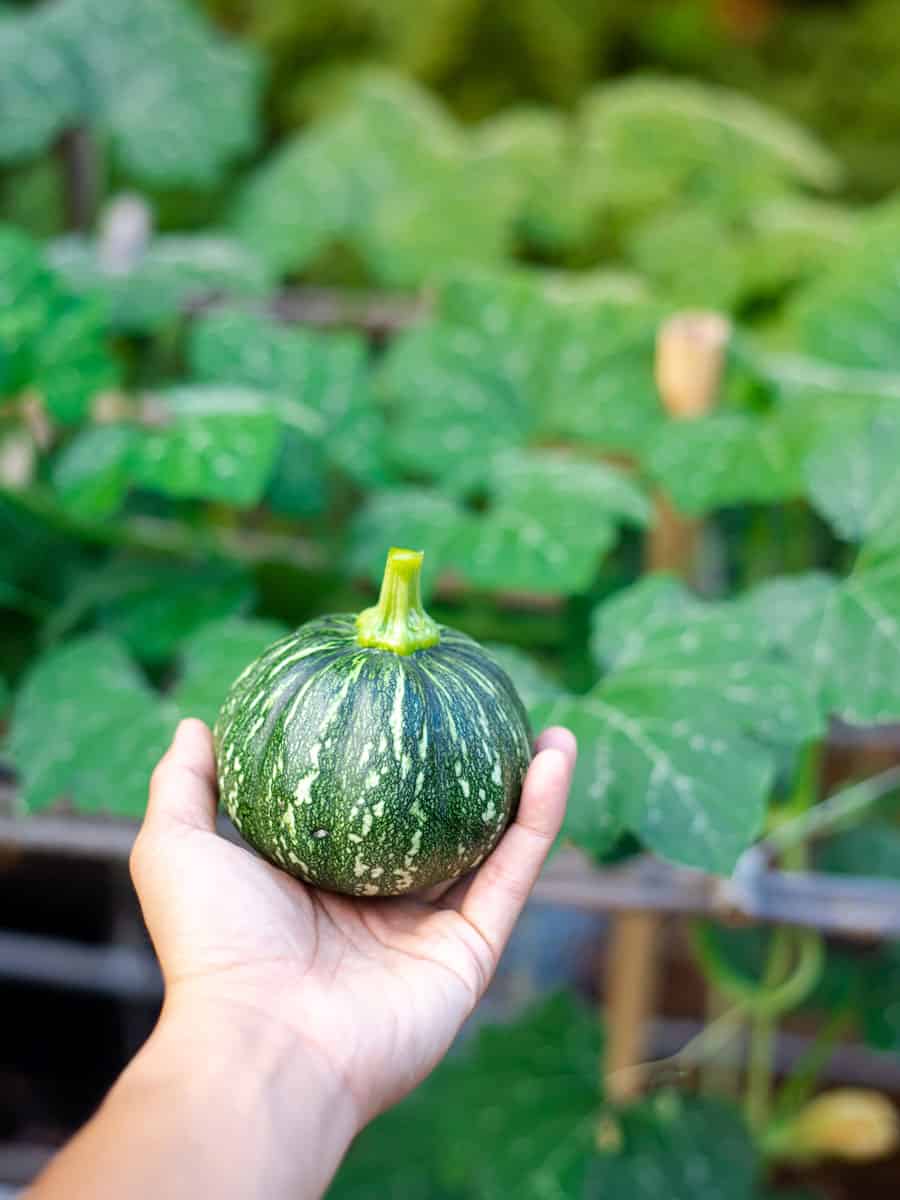
Eight Ball squash is a type of round zucchini. It has a glossy, smooth outer skin that is deep-forest green in color. The flesh of this squash is creamy white, having light green hues. The seeds are almost negligible. It has a very sweet, buttery taste that becomes more profound with cooking. The size of the fruits is 3 to 4 inches. The smaller ones taste the best!
They are a summer specialty. They require full sun for best growth. The seeds should be sowed when the temperature of the climate and the soil has turned warmer. A warm temperature is necessary for the germination of seeds. The soil should be fertile and well-drained. Eight Ball Squash needs a moist soil but a soil that is too wet may cause the seeds to rot.
This variety has been quite popular in Europe but it has become a successful commercial variety that is being sold in the United States.
It is a highly versatile variety that can be used raw, cooked, baked, stuffed, or steamed!
You can buy Eight Ball squash seeds on Amazon
31. Blue Banana Squash

Blue Banana squash varieties are shaped like a banana, only a lot larger. They have a slate-blue colored rind, having lighter colored stripes with deep orange flesh on the inside. The fruits are a large size, usually 20 inches long. The fruits are sweet in taste.
Blue Banana squashes can be traced back to Peru, from where they were traded all over America. Like all squashes, this variety also requires a full sun exposure for growth. The soil should be warm enough. The seeds should be planted after the danger of frost has completely passed. The soil should be fertile and well-drained.
These squashes are perfect for making purees for pies and soups, for baking, frying, and roasting.
You can buy Blue Banana squash seeds on Amazon.
32. Green Hubbard Squash

Green Hubbard squash is a winter squash variety. It is also known as a Green Pumpkin, owing to its green colored outer skin and a sweet taste like that of a pumpkin. Green Hubbard squashes are huge in size and can weigh as much as 50 pounds. Their outer skin is extremely hard which makes it suitable to be stored for up to 6 months.
Green Hubbard squashes are highly nutritious and wonderful in taste. The flesh is extremely sweet in taste and is used to make delicious pies!
It has its origins in South America or the West Indies. They require full, warm sun for the best growth. The soil should be rich and very well-drained. It needs an area that has plenty of open space because its vines grow long. Throughout the duration when you are growing this squash, you will need to keep the soil moisture consistent otherwise the seeds will dry out and die.
You can buy Green Hubbard squash seeds on Amazon
33. Green-Striped Cushaw Squash
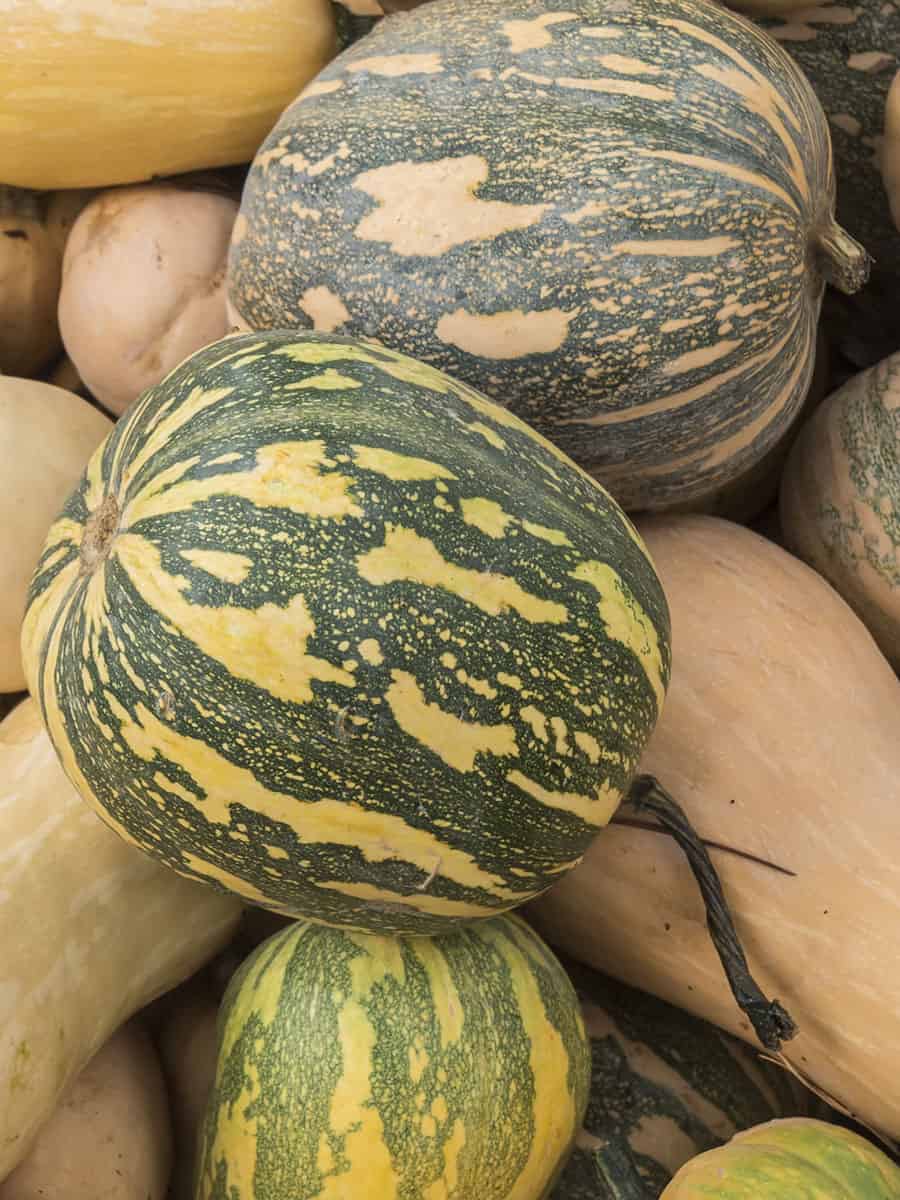
Green-Striped Cushaw squash is a winter squash that is native to the tropics of the United States. It is grown in southern and southwestern United States. The skin of these squashes is white-green, having mottled green colored stripes. The flesh of Green-Striped Cushaw is light yellow in color.
Since this heirloom squash hails from the Caribbean, it can tolerate humid conditions well. This squash needs a very specific pH range for the best growth. The pH range is 6.0 to 7.5. if the soil does not have this pH, it should be amended. The soil should be fertile and moist. Seeds should be sowed when the temperature of the soil is at least 60 degrees.
It has a mild, sweet taste that makes it suitable to be used in both sweet and savory dishes.
You can buy Green-Striped Cushaw squash seeds on Amazon.
34. Romanesco Squash
Romanesco squash is an Italian heirloom squash. It is a type of summer squash. It is distinguished by a bulbous blossom end. The fruit has ridges on its surfaces. The outer skin is dark green in color with a pale colored inner flesh.
Being a squash, the growth requirements are similar to other squash varieties. The seeds should be planted when the soil temperatures are about 70 degrees. The soil has to be consistently moist and fertile for the best growth results. The sun exposure has to be pronounced because these squashes, like all other, are summer loving that grow best in warm climates.
The flesh of Romanesco squash is creamy and has a sweet, nutty flavor that makes it suitable to be eaten raw or cooked. It is used in a number of different recipes that are delicious and mouth-watering!
You can buy Romanesco squash seeds on Amazon.
35. Moranga Squash
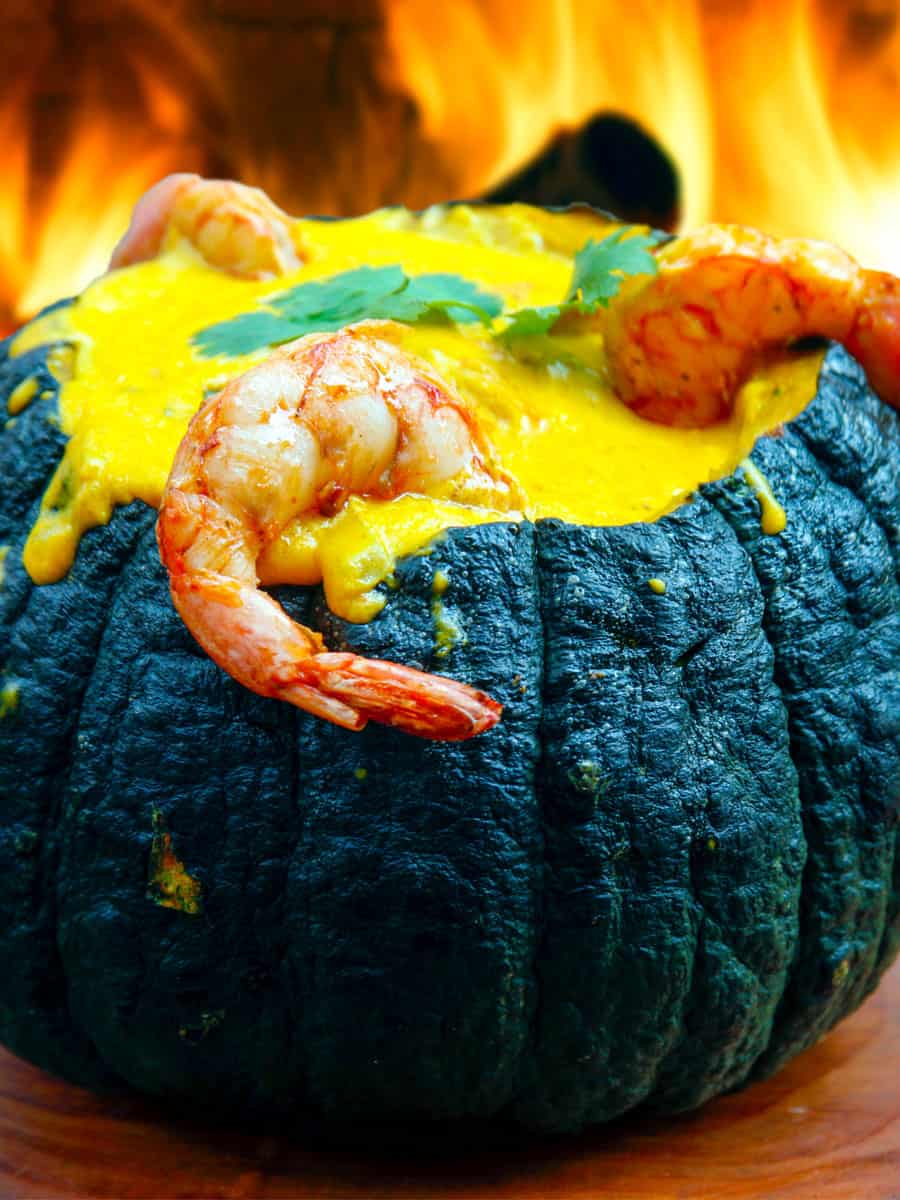
Moranga squash is a traditional squash from Brazil. It is also known as the Pink Pumpkin. The color of these squashes ranges from pink to salmon. The flesh is orange in color.
The Moranga squash requires full sun exposure, fertile, and well-drained soil for optimal growth. If the soil is not fertile enough, fertilizer should be added to ensure the plant gets enough nutrients to yield the best fruits.
This squash is a preferred squash type for a number of Brazilian dishes. it can be stored for long periods of time. Moreover, because of their pretty appearance, they make a popular decorative squash as well.
Moranga squash seeds are rare and quite hard to find. You can get them at Rareseeds.
Click here to buy Moranga quash seeds on Rare Seeds.
36. Raven Zucchini
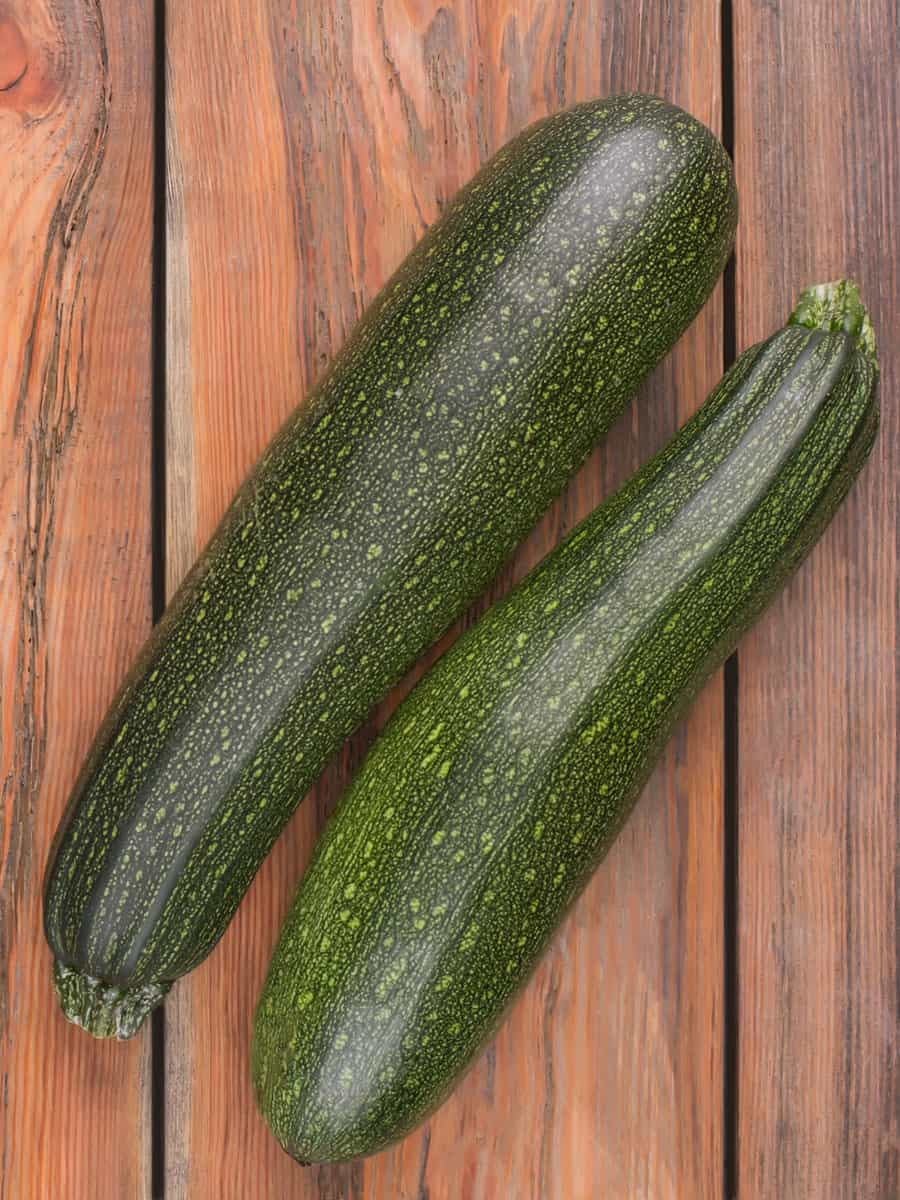
Raven zucchini is a bushy plant that does not spread vigorously all around the garden. These squashes are cylindrical in shape and are dark green in color. Their outer skin is glossy and smooth. The flesh is tender and pale.
Raven zucchini can be planted when the weather has turned warm with day and night temperatures at least 50 degrees. The need full sun and warm climate to grow. The soil should be fertile, moist, and well-drained. The soil should be fertilized and amended with compost before the seeds are sowed.
The Raven zucchini lose taste as they grow in size, therefore, they should be harvested when young (not more than 5 inches long). They are delicious in taste and can be eaten raw, grilled, steamed. They are scrumptious, no matter how you eat them.
You can buy Raven zucchini squash seeds on Amazon.
37. Astia Squash
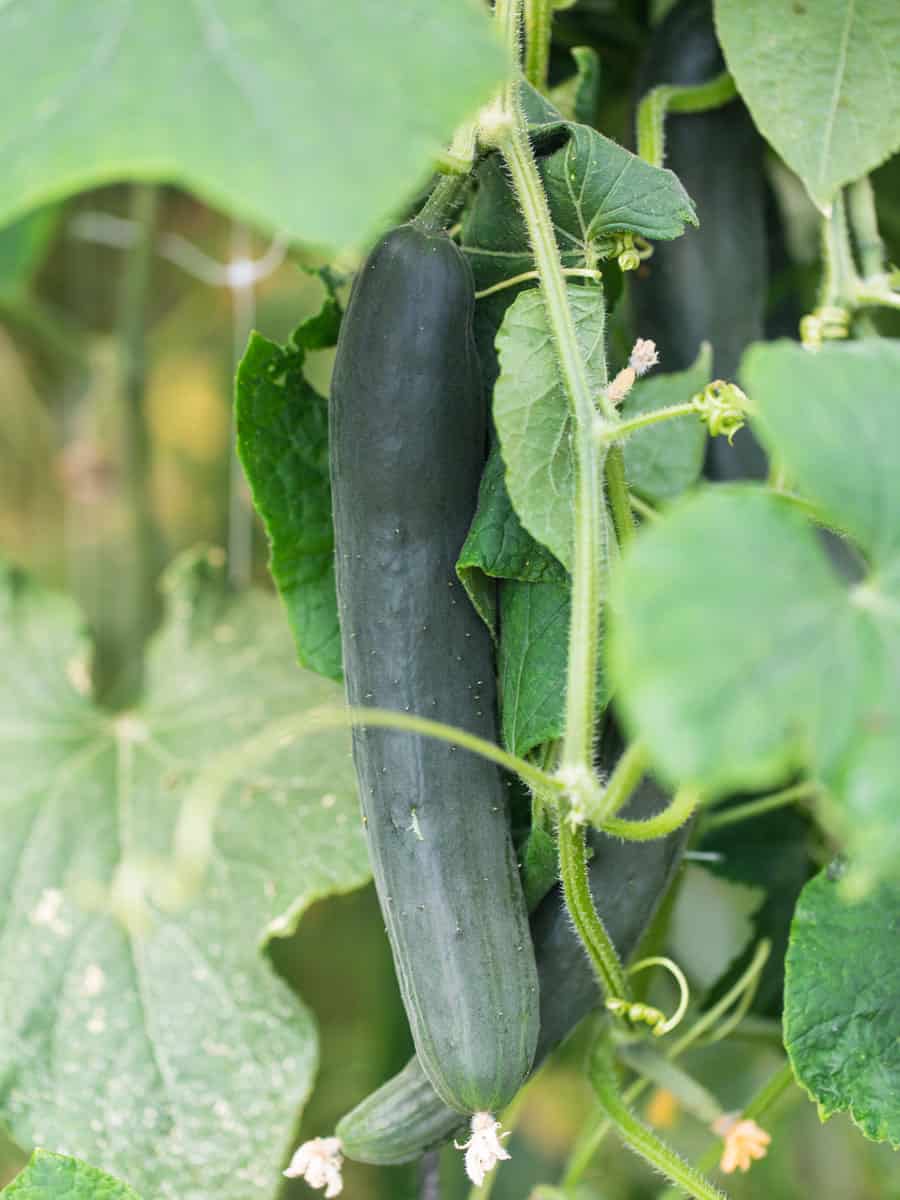
Astia squash is a French bush variety of zucchini. It has been developed to be grown in small space gardens and containers. The vines of these plants are compact and have high ornamental value owing to its silvery-green leaves.
The fruit is deep green in color on the outer surface. The skin is extremely smooth and glossy. Astia squash has excellent flavor.
Astia squashes are planted in fairly warm weather, after ensuring that the soil is warmed up to allow seed germination. When planting in containers, good, fertile soil should be used to sow seeds. The containers should be placed in an area that receives full sun. Moreover, the plants should be watered with caution because if the soil becomes too moist, the seeds will rot.
With a delicious taste, these squashes taste amazing when grilled, baked, steamed, or sautéed. They can be roasted or even topped on pizza.
You can buy Astia squash seeds on Amazon.
38. Caserta Squash
Caserta squash is a summer squash variety. It is a bush type plant rather than spreading vine type. Caserta squashes are about 16 inches in length. They are gray-green in color, having dark green stripes running across the length.
They are easy to grow and easy to maintain types of squashes. The seeds are to be planted in warm soil when the temperature is about 70 degrees. They are heavy feeders, which means that the soil should be highly fertile. If the soil quality is poor, it needs to amended and fertilized. They require regular watering.
Caserta quashes are very flavorful. They are extremely popular in Italy where they are used in numerous recipes.
You can buy Caserta squash seeds on Amazon.
39. Ash Gourd Pumpkin

Ash Gourd Pumpkin is more commonly known as Wax Gourd. Other common names are White Gourd, Ash Gourd, Ash Pumpkin, Chinese Preserving Melon, and Winter Melon. It has a very large fruit that can grow to be as big as 80cm in length. A mature Ash Gourd has a very smooth, waxy outer skin hence the name Wax Gourd. The skin is dark green in color while pale flesh, which is usually bland in taste.
It is native to Southeast and South Asia. It is thought to have originated in Japan and Java.
Ash Gourd requires well-drained, loamy, and sandy soil for best growth. It prefers growing in warmer climates. They are mostly found growing in furrows or riverbeds. They need constant watering during their growing season.
Ash Gourd is widely used as a vegetable all over Asia. It is cooked in a variety of ways, as a part of many recipes. Not just culinary uses, Ash Gourd also have medicinal importance in the Ayurveda System of Medicine.
You can buy Ash Gourd Pumpkin seeds on Amazon.
40. White Custard Squash

White Custard Squash is a type of Patty pan Squash. It is a bush type squash that produces flat fruits having scalloped edges. The color of the fruits is creamy white. The white is very delicate. The flesh tastes very fine.
Grow them in containers and pots, as well as in the garden. They need a very fertile soil so make sure to feed the soil with lots of compost and fertilizer before sowing seeds. The right place to grow these squashes is a place that receives full sun. These squashes, like others in the same class, grow best in warm weather.
These squashes can be roasted on the grill whole or sliced. Either way, they taste delicious.
You can buy White Custard squash seeds on Kings Seeds
Click here to buy White Custard Squash seeds on Kings Seeds.
41. Tennessee Sweet Potato Squash
Tennessee Sweet Potato a pear-shaped squash that has a taste similar to that of sweet potato. The fruit is pale green in color with dark green colored stripes. The flesh is also pale in color. Some people say it is sweet in taste which makes it perfect for pies, while others argue that their taste is more on the bitter side.
Unlike all other squash varieties that we have discussed above, these squashes grow well in cooler climates. It has been observed that when the weather becomes cooler, the productivity of these squashes sis greatly increased. As for the soil type, they are heavy feeders and they require a rich, fertile soil that is significant quantities of compost.
Being similar in taste to sweet potatoes, they are used to make pies. It is more commonly used for decorative purposes.
You can buy Tennessee Sweet Potato squash seeds on Seed Savers Exchange. Click here to buy.
42. Shishigatani Squash
Shishigatani squash is also known as Toonas Makino Pumpkin. It is native to Japan but even there, it is very hard to find. It produces bottle-shaped fruits that have a dark green to green-blue colored rind that fades to tan when the fruit is fully mature. The rind is warty and ribbed. The flesh is pale.
These squashes can grow to be 8 inches long. The taste of these squashes is not very delicious yet they are quite famous in Kyoto, Japan and are commonly seen displayed outside restaurants and in supermarkets. It is used as an ornamental fruit because of its unique shape. It is also used for medicinal purposes.
You can buy Shisigatani squash seeds on Amazon.
43. Indian Tinda Squash
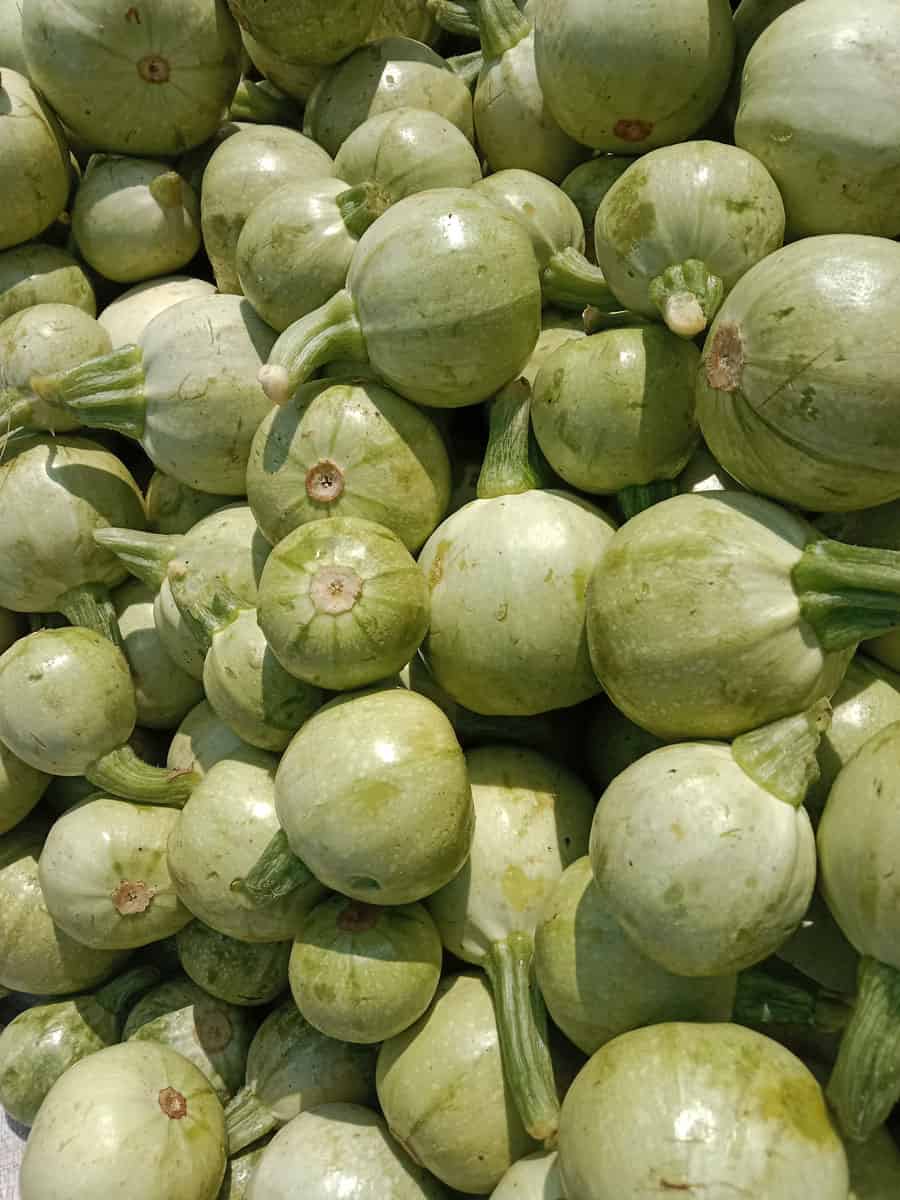
Tinda squash is native to India and is a very popular squash used in curries in Indian and Pakistani cuisines. It is also known by names of Indian squash, Indian Round Gourd, Round Melon, Indian Baby Pumpkin, and Apple Gourd. It is green in color, having a size similar to that of an apple. Tinda squash plant grows vigorously and starts to produce fruit in just 70 days after planting.
It tastes bland. Not many people like it. However, it is cooked in curries with plenty of spices in India and Pakistan.
They are easy to grow. They require a rich, fertile, and well-drained soil. Adding a lot of compost can also improve the growth of these squashes. It grows best when the temperature is warm, especially in sub-tropical and tropical conditions.
You can buy Tinda squash seeds on Amazon.
44. White Cushaw Squash
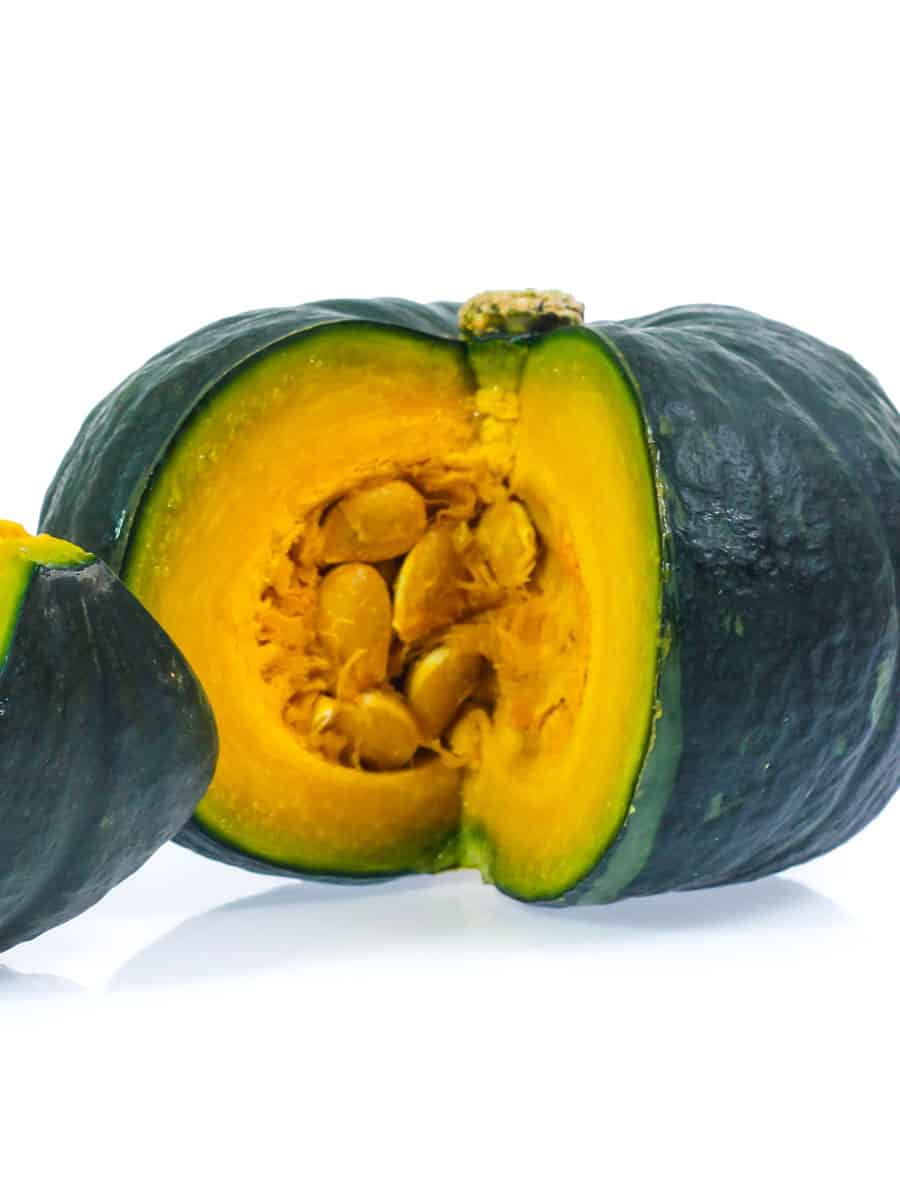
White Cushaw Squash is also known as Jonathan Pumpkin. It produces a white colored fruit with faint green lines that are quite big in size. the fruit can weigh as much as 20 pounds. The skin of these squashes is very smooth, so much that they appear to be glowing.
Their flesh is not very tasty. It is more on the bland side. However, they are very often used for decorative purposes.
These squashes are easy to grow and maintain. If they get the right warm temperature and well-drained soil, they can perform pretty well.
You can buy White Cushaw squash seeds on Amazon.
45. Autumn Delight Squash
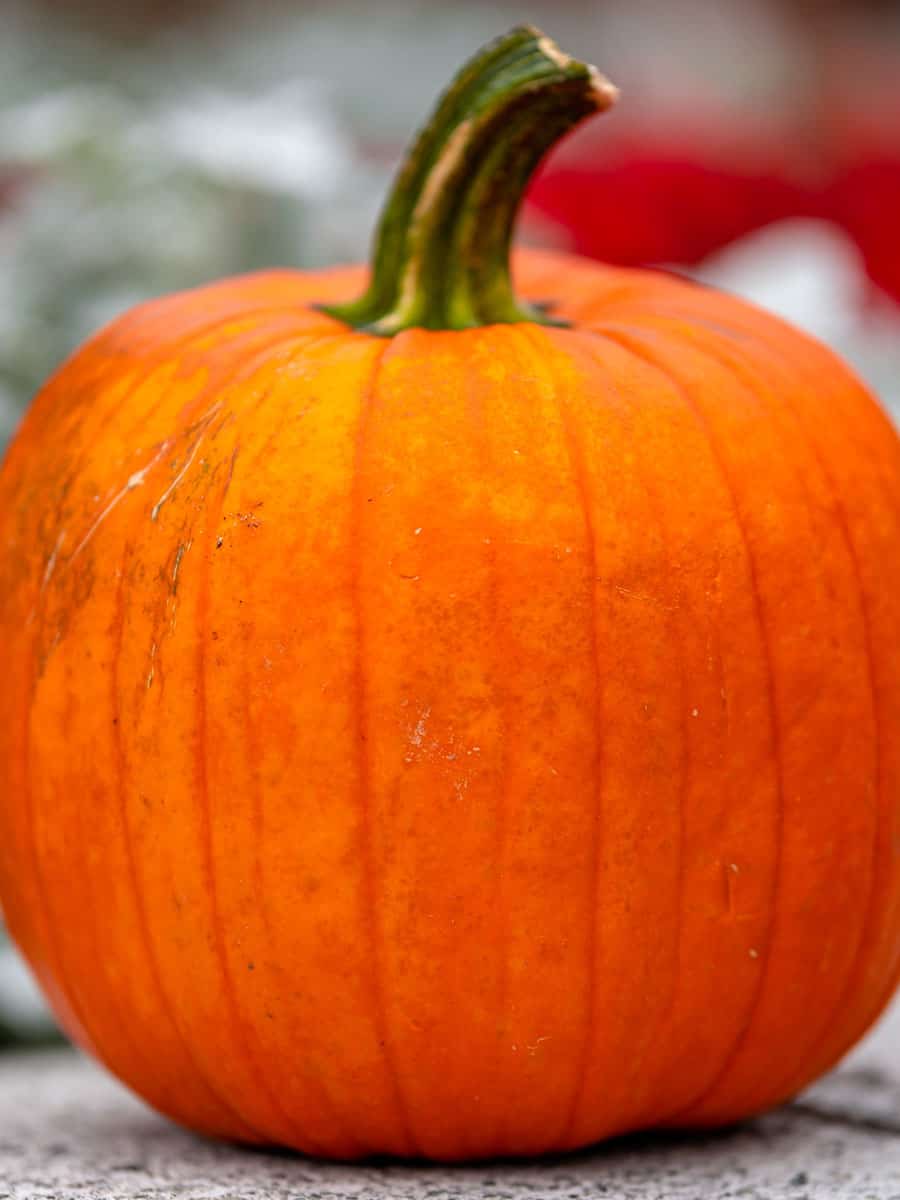
Autumn Delight Squash is an acorn with larger sized fruit and better resistance o powdery mildew. It has dark green skin and light orange colored flesh. The fruit usually weighs around 1 to 2 pounds. Autumn Delight squashes are bush type plants that do not have long growing vines, making them suitable to be planted in small gardens.
You can buy Autumn Delight squash seeds on Amazon.
46. Golden Cushaw
Golden Cushaw is a winter squash variety. It is a type of Butternut squash. The fruit is golden-orange or yellow-golden in color that is usually 12 to 20 pounds in weight. The fruit is usually thick and U-shaped.
Golden Cushaw has a vining growth habit and therefore it needs a lot of space to grow. It grows best in warm weather, in soil that is fertile and well-drained. It can grow well in neutral and mildly acidic soil with a pH in range 6.1 to 7.5.
The flesh of Golden Cushaw is sweet and therefore is widely used in numerous recipes. It is also used for decorative purposes.
Click here to buy Autumn Delight squash seeds on KCB Samen.
47. Lunga Di Napoli Squash

Lunga Di Napoli is a variety of squashes that produces huge, dark green colored fruits. It is winter squash type that grows long vines. The flesh tastes sweet and is used in stews, soups, salads, and sweets!
It grows best in warm climates when the soil temperature is raised. The soil should be fertile, well-drained, and moist. Before sowing seeds, the soil should be treated with compost to ensure the soil is suitable for the growth of these squashes. When temperatures are fairly dry as in droughts, they need regular irrigation.
48. Table King Squash
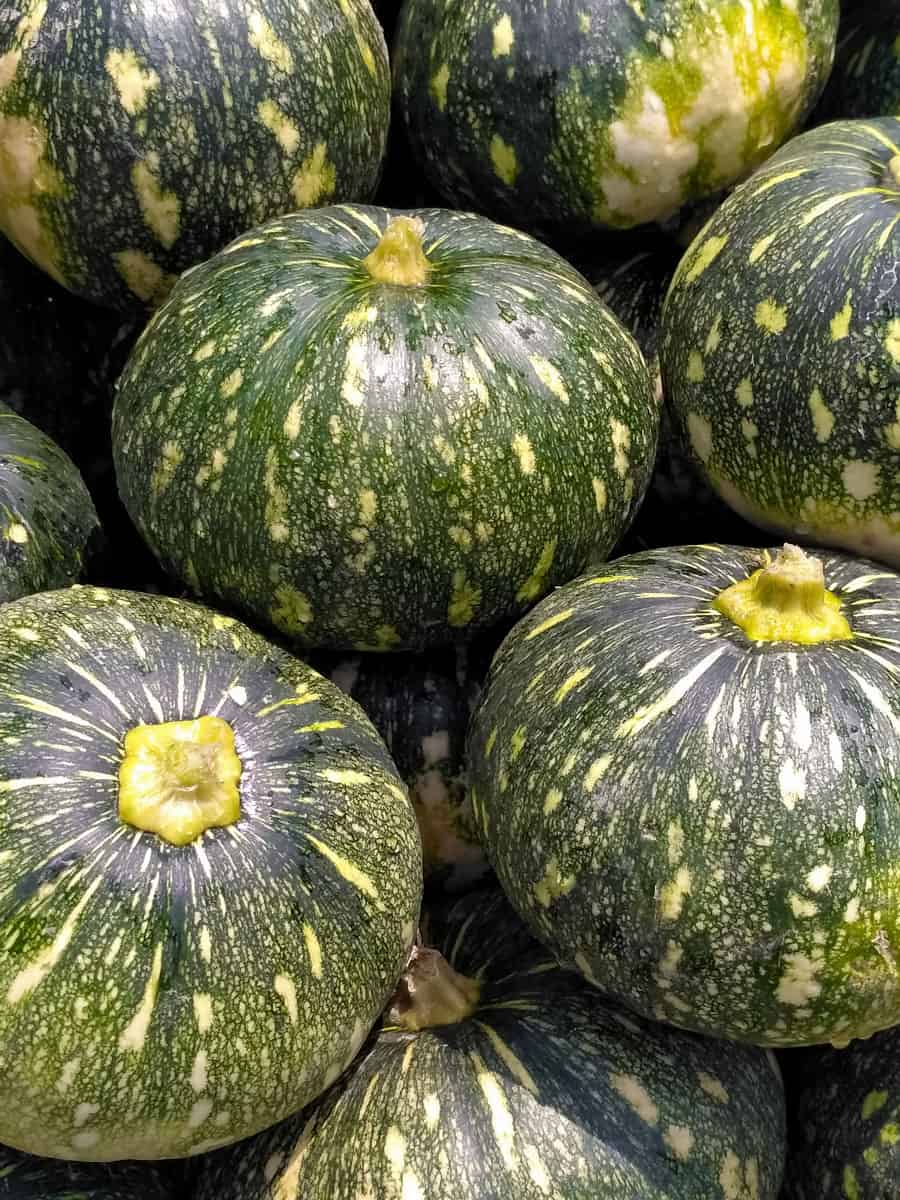
Table King Squash is an winter acorn variety. They produce fruits that have a smooth, glossy, dark green colored skin and a light orange flesh. The flesh is dry, dense, and extremely flavorful.
They are bush type plant, making them suitable to be grown in small gardens. Table King Squashes grow best in loose, well-drained, rich, and fertile soil. The ideal pH for their maximum growth is 5.5 to 6.5. They require full sun exposure for best growth.
These squashes can be stored for a very long time. They are used for culinary purposes. Table King Squashes make great Thanksgiving gifts!
You can buy Table King Squashes seeds on Amazon.
Now that you know all there is to know about the types of squashes that you can grow, we hope you have a great, successful squash growing experience! Don't forget to check out our guide about 73 varieties of pumpkin too!








































